|
March 3, 2018 - No. 8
International
Women's Day
2018
All Out to Affirm
Women's Rights!
PDF
For
Your
Information
• Child Care in Canada
• Facts About Women in the Workforce
Ruling Elite Continue
Push for Integration and
Continental Corridors for Trade
• Rounds Six and Seven of NAFTA Negotiations
• Integration of Mexican,
Canadian
and U.S. Regulatory Bodies
• Control Over Energy Resources and
Their Transport
• Push for Trade Corridors Under U.S.
Control
Justice for Missing
and Murdered Indigenous Women
• Cross-Canada Actions Demand Justice for Tina
Fontaine
• Walking with Our Sisters Mnidoo
Kweok Exhibit
Visits Sudbury and Kenora
Robinson Huron Treaty
Annuities Hearings in Sudbury
• Anishinaabek People Oppose
Liberal Hypocrisy
and Fight for Treaty Rights
- David Starbuck -
Shooting at School in
Parkland, Florida
• No Means No! Enough Is Enough!
Students Organize for Change
Fifth Anniversary of
the
Death of Hugo Chávez
• Long Live the Legacy of
the Founder
of the Bolivarian Revolution!
- Margaret Villamizar
-
Supplement
• Robinson Treaty with Ojibewa of Lake Huron
Conveying
Certain Lands to the Crown
International Women's Day 2018
All Out to Affirm Women's Rights!
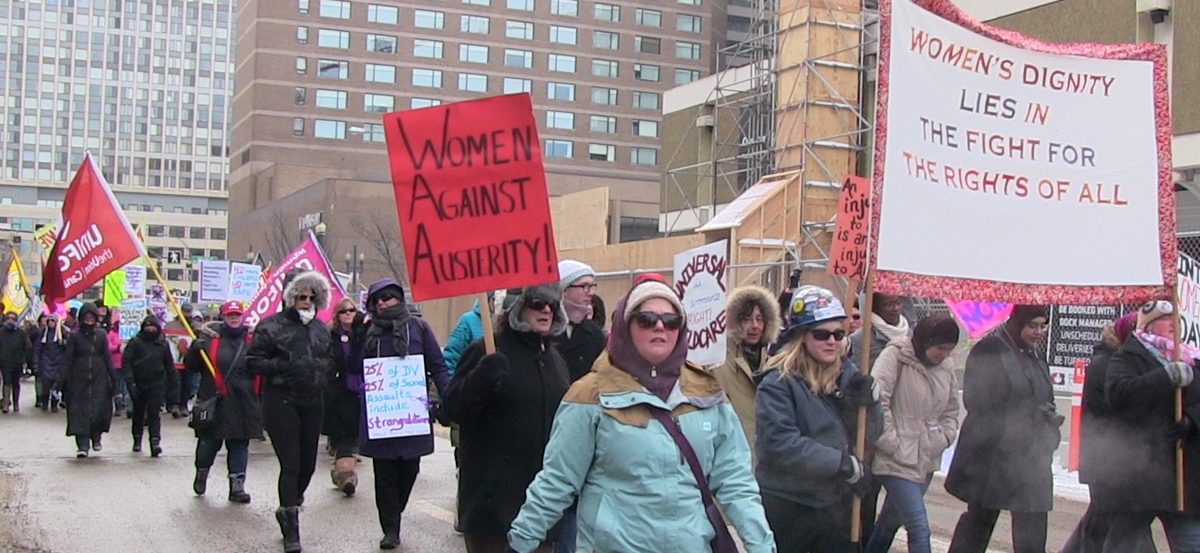
Edmonton, International Women's Day 2017.
 The Communist Party of Canada
(Marxist-Leninist) salutes
the women of Canada, Quebec and the Indigenous peoples and women
the world over on the occasion of International Women's Day 2018.
The fight waged by women and girls to affirm their rights is
courageous, heroic, inspiring and decisive in the fight for the
rights of all. At a time counter-revolution has the initiative
worldwide, with its vicious neo-liberal agenda, anti-social offensive,
privatizations, aggressions and wars, women stand in the front ranks of
the struggle to affirm their rights in all fields of human endeavour.
This is the struggle that opens society's path to progress, especially
since all these attacks are carried out, amongst other things, in the
name of women and their rights! To the chagrin of the elites, women are
not fighting for their rights to satisfy the
agenda of elites but to make sure conditions are brought into
being where even the notion of women as a legitimate target of attack
is a thing of
the past. On this occasion, CPC(M-L) calls on all members of the
polity to stand as one to affirm a society which does not
discriminate against women and girls and consider them fair
game. The Communist Party of Canada
(Marxist-Leninist) salutes
the women of Canada, Quebec and the Indigenous peoples and women
the world over on the occasion of International Women's Day 2018.
The fight waged by women and girls to affirm their rights is
courageous, heroic, inspiring and decisive in the fight for the
rights of all. At a time counter-revolution has the initiative
worldwide, with its vicious neo-liberal agenda, anti-social offensive,
privatizations, aggressions and wars, women stand in the front ranks of
the struggle to affirm their rights in all fields of human endeavour.
This is the struggle that opens society's path to progress, especially
since all these attacks are carried out, amongst other things, in the
name of women and their rights! To the chagrin of the elites, women are
not fighting for their rights to satisfy the
agenda of elites but to make sure conditions are brought into
being where even the notion of women as a legitimate target of attack
is a thing of
the past. On this occasion, CPC(M-L) calls on all members of the
polity to stand as one to affirm a society which does not
discriminate against women and girls and consider them fair
game.
Women are also playing a leading role in the work to
renew
the democratic process. They are fighting for government of laws
against the use of police powers which criminalize all members of
the polity, turning them and their collectives
into objects that allegedly threaten the national interest and
national security. It must not pass!

Vigil on Parliament Hill, October 4, 2017, demands justice for Missing
and Murdered Indigenous Women and Girls.
On this occasion, we think
the courageous stands taken by Indigenous women and their families
deserve special
commendation. Their voices rise ever louder against the
conditions which permit their mothers, sisters, children,
grandmothers and aunts to be murdered and disappeared. The fact
that the state maintains colonial relations which permit this to
be done with impunity shows above all else that the people
require the political power to change this and create a modern
Canada which realizes the dream of nation-to-nation relations
with the Indigenous peoples.

Women's March,
Toronto, January 21, 2017. Women across Canada joined those in the
U.S. standing in the forefront of the fight for their rights and the
rights of all, in
opposition to the
Trump presidency.
It is the voices of the women which
represent this political power at this time. No number of
attempts to silence them or to hand over the fate of women
and girls to an alien authority have silenced this voice which
is getting stronger and stronger. It is our duty to help this
voice be heard, to add our voices so that those who commit the
crimes and those who cover up the crimes, no matter who they are,
are brought to justice. Once again it is the women who are
inspiring all members of the polity to lay the claims which they
must and take up social responsibility to do whatever is required
to open society's path to progress.
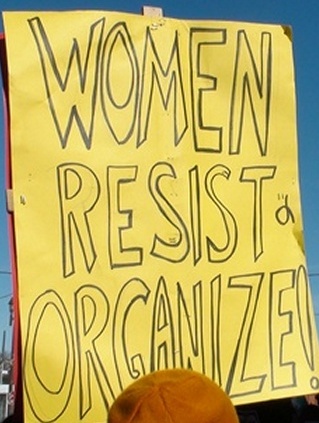 By laying the claims which we must,
resistance to all
forms
of oppression and humiliation gives rise to the new quality
required today to bring into being a world where every woman,
every child, every human being and their collectives
flourish. By laying the claims which we must,
resistance to all
forms
of oppression and humiliation gives rise to the new quality
required today to bring into being a world where every woman,
every child, every human being and their collectives
flourish.
Nearly 50 years ago, a Royal Commission was held on the
Status of Women. Its report amongst other things exposed the
extent of wage discrimination against women and called for a
national child care program. Today, nearly 50 years later, women
still earn on average 73 per cent of the wages of men. Not only are the
rights of women as members
of a class which produces the wealth society depends on for its
living not recognized but their role as those who reproduce life
and are the main caregivers of children is still not recognized.
Governments do not even acknowledge that in a modern society and
socialized economy the care of children and elders is the
responsibility of society. Women and families cannot be left to
fend for themselves. Declarations, promises, and pronouncements
from the ruling circles are based on paternalism, a feudal trait.
They not only aim to cover up the reality that the continuing
oppression of women is integrally linked with capitalist
exploitation, but to smash any attempt of the members of the
polity to unite in action for political renewal. Today the
working class is formulating a nation-building project which
vests political power in the people. This will end the situation
in which the "sovereign" represents private interests which act
in the name of the people to keep the people disempowered.
Through their actions, women
speak, organize and collectively
take decisions which favour them and all matters which concern
them. This is how they address problems of the present. This is
how their actions in the present inform the kind of future which
we leave all children. When women lay the claims which they must
it contributes to the work for democratic renewal. It does not
and will never provide legitimacy for institutions which work
against them, be they governments, legislatures or social and
political organizations no matter which or where.
 One hundred and seven years ago,
the first
International
Women's Day was celebrated to focus on the call for peace issued
by communist women in Europe prior to the First World War. Since
then, life experience has confirmed that women are the mightiest
force for peace on the world scale. This is represented today by
the work to Make Canada a Zone for Peace and to establish an
anti-war government which gets Canada out of war alliances,
coalitions and cartels of all kinds, including economic,
military, cultural or any other. Today, Canada is embroiled in all
U.S. wars of aggression, occupation and regime change. It is a member
of alliances and coalitions which are threatening all peoples who
refuse to submit to U.S. dictate. On the occasion of
International Women's Day 2018, let us step
up the fight to establish an anti-war government and make Canada
a Zone for Peace. One hundred and seven years ago,
the first
International
Women's Day was celebrated to focus on the call for peace issued
by communist women in Europe prior to the First World War. Since
then, life experience has confirmed that women are the mightiest
force for peace on the world scale. This is represented today by
the work to Make Canada a Zone for Peace and to establish an
anti-war government which gets Canada out of war alliances,
coalitions and cartels of all kinds, including economic,
military, cultural or any other. Today, Canada is embroiled in all
U.S. wars of aggression, occupation and regime change. It is a member
of alliances and coalitions which are threatening all peoples who
refuse to submit to U.S. dictate. On the occasion of
International Women's Day 2018, let us step
up the fight to establish an anti-war government and make Canada
a Zone for Peace.
Join events which celebrate International Women's Day
across
the country! They get going on Saturday, March 3. Join in laying
the claims for more investments in social programs, adequate
wages, childcare and senior's care, against criminalization of
speech and social action, for justice for Indigenous women and
girls and nation-to-nation relations with the Indigenous peoples
within a modern Canada and against aggression and war. All out to
uphold the rights of women and girls!
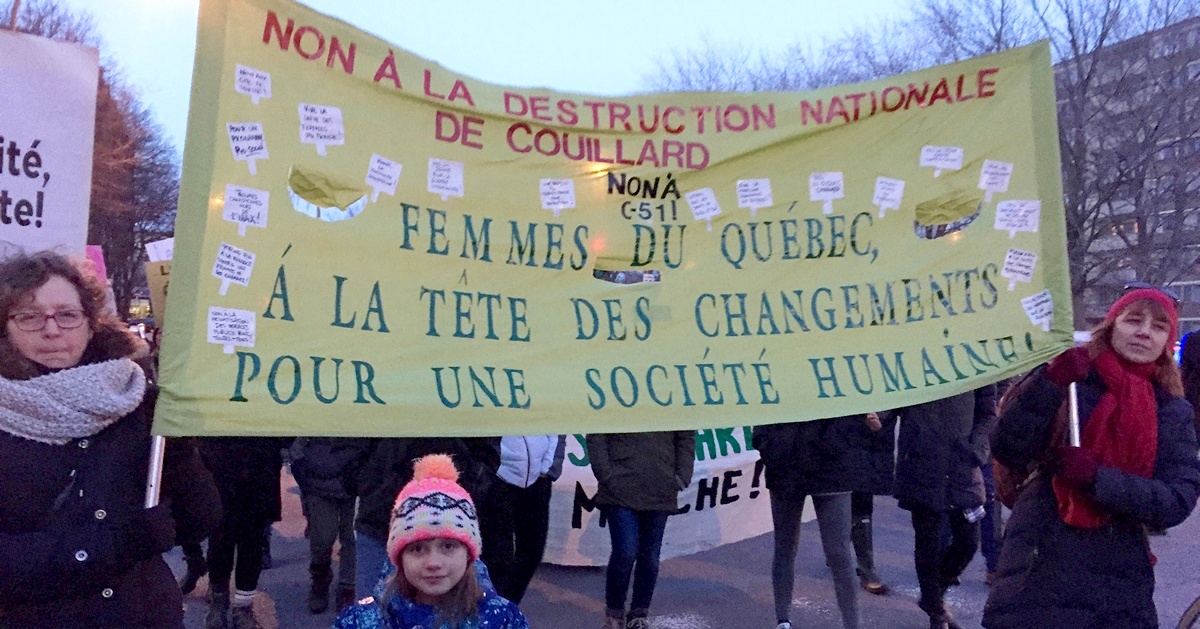
Montreal, International Women's Day 2017.

For Your
Information
Child Care in Canada
The UN Committee on the Elimination of Discrimination
against Women (CEDAW) reported in November 2016 that Canada
failed to uphold rights when it came to child care. It
recommended that Canada take action to make child care more
affordable and accessible, and called on Canada to adopt "a
rights-based national child care framework in order to provide
sufficient and adequate child care facilities."
The UN CEDAW Committee noted that Canada's federal
government
has an obligation to "take necessary legislative measures to give
full effect to the Convention on discrimination against women,"
and to "provide leadership to the provincial and territorial
governments in that context."
 Canadian and Indigenous women's
organizations and child care
advocates agree that the government must recognize rights by
providing affordable child care, upholding the rights of early
childhood educators to wages and benefits commensurate with the
value they create, and expanding public and not-for-profit private day
care, with no expansion of private for-profit care. They
further call for a National Child Care Program to uphold the
rights of children, women and workers in early childhood
education and child care. They point out that services are scarce,
child care space availability is uneven, fees are unaffordable,
quality is uneven, and workers are grossly underpaid for the
important work they do and value they add to the economy. Canadian and Indigenous women's
organizations and child care
advocates agree that the government must recognize rights by
providing affordable child care, upholding the rights of early
childhood educators to wages and benefits commensurate with the
value they create, and expanding public and not-for-profit private day
care, with no expansion of private for-profit care. They
further call for a National Child Care Program to uphold the
rights of children, women and workers in early childhood
education and child care. They point out that services are scarce,
child care space availability is uneven, fees are unaffordable,
quality is uneven, and workers are grossly underpaid for the
important work they do and value they add to the economy.
A recent study by West Coast Leaf found that outside
of
Quebec and Manitoba, where parent fees are capped for regulated
day care spaces, median child care fees range from 23 to 36 per
cent of median pre-tax income for women aged 25 to 34. In other
words, mothers in most Canadian provinces pay three to four
months of their annual salary on child care costs.
Overall, Canadian families spend almost one-quarter of
their
income on
child care, a ratio that is much higher than in other parts of
the world, according to a report issued in 2016 by the
Organization for Economic Co-operation and Development (OECD).
In 2014, regulated child care spaces were available for
only
24 per cent of children from birth to age five. The Trudeau Liberals
say
they will invest $7.5 billion over 10 years on child care, with
the amounts starting at $500 million in 2016-17 and rising to
$870 million by 2026. This includes funding to provinces and
territories as well as to provide Indigenous child care on and
off reserve. It has been estimated that the federal funding could
create about 13,000 subsidized spaces a year over the next three
years, or about 2.4 per cent of the roughly 543,000 regulated
child-care spaces in Canada for children five and under. The
total amount is even less than contained in the 2005 national
child care plan introduced by the Paul Martin government but
cancelled by the Harper government before it got off the
ground.
The Trudeau Liberals also introduced the Canada Child
Benefit
which the government says will help bring more women into the
work force by making child care more affordable. The Canada Child
Benefit is a Harper-era program that the Liberal government
modified to provide larger payments to lower income families,
with payments decreasing as family income rises. Families with
income under $30,000 would benefit the most. The Parliamentary
Budget Officer (PBO) reported that families with incomes of
$65,000 and over would see an average increase of about $1,000 a
year to their child care benefits. The number of eligible
families was reduced by 13 per cent. The PBO did not factor in the
impact
of the cancellation of other Harper era tax credits including the
Children's Fitness and Arts Tax Credits, the Education Tax Credit
and Textbook Tax Credit for youth in post-secondary education.
The Public Transit Tax Credit was also cancelled. The Harper
government's Income Splitting Tax Credit which would have reduced
taxes for families with a significant difference in the wages
earned by the two partners was also cancelled. The experience of many
families shows that the Trudeau government's claim to have
implemented a feminist child policy is exaggerated. When
these changes are factored in, many families have seen little
improvement or actually receive a smaller child benefit under
Trudeau's plan, which does not recognize that child care is a
right.
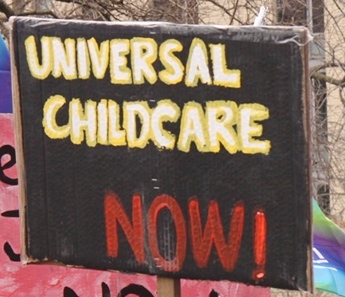 The child benefit obviously will
help some families with those costs, but it's not big enough to make a
material difference in places such as Vancouver and Toronto, where the
median cost of childcare each month is $1,360 and $1,758, respectively,
the Centre for Policy Alternatives has pointed out. And while a
subsidized space in Montreal cost $178 a month, Quebec's subsidized day
care program only provides spaces for about one in three kids in day
care.[1] Child care advocate and
scholar Martha Friendly noted that the benefit may not actually
encourage women to seek work outside the home. For a new job to make
sense, a stay-at-home parent would have to earn enough to cover child
care and whatever her or his family would lose from the child benefit. The child benefit obviously will
help some families with those costs, but it's not big enough to make a
material difference in places such as Vancouver and Toronto, where the
median cost of childcare each month is $1,360 and $1,758, respectively,
the Centre for Policy Alternatives has pointed out. And while a
subsidized space in Montreal cost $178 a month, Quebec's subsidized day
care program only provides spaces for about one in three kids in day
care.[1] Child care advocate and
scholar Martha Friendly noted that the benefit may not actually
encourage women to seek work outside the home. For a new job to make
sense, a stay-at-home parent would have to earn enough to cover child
care and whatever her or his family would lose from the child benefit.
Basic Information on the Canada Child Benefit
Budget 2016 introduced the Canada Child Benefit.
Starting in July 2016, the new Canada
Child Benefit provides a maximum annual benefit of $6,400 ($533 a
month) per
child under the age of six, and $5,400 ($450 a month) per child
aged six through 17. The full benefit is payable
only if family income is below $30,000 a year. For example, a
family with a median household income of $70,000 in 2015 would
receive $324 a month with one child or $3,890 a year and $8,586 a
year with two kids under six. The benefit is not considered
taxable income, however an income tax return must be filed in
order to receive the benefit.
The Canada Child Benefit replaced the Universal Child
Care
Benefit introduced by the Harper government of $160 a month per
child under six and $60 for kids between six and 17; the Canada Child
Tax Benefit (an additional income-tested family benefit); the
National Child Benefit (a supplement for low-income families);
and the Conservative's "Family Tax Cut" which involved income
splitting for families with children under 18, and lowered
taxes payable by up to $2,000 when one parent or guardian made
significantly more than the other. The Children's Fitness Tax
Credit and Children's Arts Tax Credit were also phased out. The
Universal Child Care Benefit was taxable income, while the Canada Child
Benefit is not.
The Parliamentary Budget Officer (PBO) estimated in a
2016 fiscal analysis that the
average payment under the Canada Child Benefit would increase by $1,858
annually for all
families, with the greatest benefit to families with adjusted net
income below $30,000. Without the recently announced adjustments
for inflation, the PBO estimated that the benefit would have
fallen to the level of the Harper government's programs by
2018.
One out of 10 eligible families, or 477,000 people
deemed
eligible did not receive the benefit in its first year.
Taxpayers' ombudsman Sherra Profit reported that women living in
shelters and Indigenous women on reserve experience
difficulties receiving their benefits.
Note
1. The Globe and Mail, April 17, 2017,
carried an article based on a report by the Quebec government titled, Situation des centres de la petite
enfance,des garderies et de la garde en milieufamilial au Québec
en 2013. The Report analyzed reports of activities in
2012-2013 submitted in March 2015 by those involved in delivering the
Quebec child care program. The Globe
wrote: "Universal is also a misnomer when it comes to the Quebec
system. Only 35 per cent of the 250,000 Quebec children attending some
form of daycare in 2013 had a coveted spot in a public Centre de la petite enfance, with
its highly structured activities and multicertified caregivers. Most
Quebec children (38 per cent) in licensed child care are still cared
for in a so-called family setting, often by a neighbour who runs a
daycare out of her home. While some parents prefer this type of
arrangement, many others fear their kids are being shortchanged by
second-class care."

Facts About Women in the Workforce
 In December 2017 Statistics Canada
reported there were 15,169,800 women in Canada over the age of 15. Of
these 9,326,500
were in the workforce, with 8,780,900 employed and 545,600
unemployed (not working and actively looking for work) for an
overall participation rate of 61.5 per cent. Women make up 47.5
per cent of the labour force in Canada. In December 2017 Statistics Canada
reported there were 15,169,800 women in Canada over the age of 15. Of
these 9,326,500
were in the workforce, with 8,780,900 employed and 545,600
unemployed (not working and actively looking for work) for an
overall participation rate of 61.5 per cent. Women make up 47.5
per cent of the labour force in Canada.
In the core working age between 25 and 54 years, 82.9
per cent of women participated in the paid labour market (2017). This
is only eight per cent less than men in the same age group.
Among youth under the age of 25, 57.2 per cent of young
women
were employed, compared to only 54.4 per cent of young men
(2015).
Women's participation rate in the workforce is
measurably lower in metropolitan areas with high day-care fees because
regulated child care is available to only 20.5 per cent of children in
Canada under the age of 12 and this affects mothers' participation in
the work force.
As a result, the employment rate for mothers between 25
to 54 years of age with children under fifteen, was 75 per cent (2013).
Canada is ninth among the 35 member countries of the Organization for
Economic Co-operation and Development in the participation rate of
mothers in the workforce.
Three-quarters of the people working part-time in 2015
were
women; 18.9 per cent of employed women worked part-time, compared
to 5.5 per cent of employed men. The number of part-time jobs in
Canada increased by 153,700, a rate two-and-a-half times greater
than the 60,400 increase in full-time jobs (2016).
In the period between 1993 and 2016, the percentage of
young
women working part-time has increased by 10 per cent. Of those
who worked part-time, 67.2 per cent of women, compared to 53 per
cent of men, reported they wanted to work less than 30 hours a
week. The most common reason, cited by 25 per cent of women, for
working part-time was caring for children.
The number of multiple job holders has also increased,
with
959,000 people working more than one job. Between 1976 and 2015,
the number of multiple jobholders rose from 2.2 per cent of the
workforce to 5.3 per cent. Most are women.
More than 1.5 million people -- nine per cent of the
workforce
-- were classified as self-employed for tax purposes, with
approximately a half million entering and leaving self-employment
each year. This high turnover rate suggests that people turn to
self-employment to avoid joblessness, not by choice. Of those
self-employed, 38.8 per cent were women. Only 34.2 per cent of
self-employed women owned an incorporated business, compared to
53.2 per cent of men, and they were also less likely to employ
paid help.
Thirty one per cent of women workers fifteen years and
older
had precarious work, either self-employed, working in temporary
jobs, or working part time involuntarily.
The percentage of people over 55 remaining in the work
force
has increased dramatically in Canada, from 24 per cent in 1996 to
a record high of 38 per cent in 2016, with 32.4 per cent of women over
55
still in the work force.
A person is considered unemployed if they are not
working
but are actively looking for work. Since 1991 women have had a
lower unemployment rate than men. In contrast, from the mid 1970s
to the late 1980s, the unemployment rate for men was usually
below that for women. The only exception to this trend was in the
early 1980s, when the recession affected considerably more men
than women. Again, during the economic recessions in the early
1990s and in 2008-9, the gap between male and female unemployment
rates increased as the unemployment rate rose more steeply for
men than women. This is because of the greatest loss of jobs
during these recessions was in the male-dominated,
goods-producing sector.
This gender difference in unemployment rates between
women
and men is more acute among the youth. While the gender gap in
unemployment rates was less than one percentage point in favour
of women in the core working ages in 2015 (6.2 per cent for men
compared to 5.4 per cent for women), it was 3.7 percentage higher
for men than women amongst the youth (15.0 per cent for men
compared to 11.3 per cent for women).
Two factors contribute to this state of affairs. First,
women
are over-represented in industries with the greatest
concentration of youth (retail trade and accommodation and food
services). Second, more women than men pursue post-secondary
education. This is reflected in gender differences in the type of
work they seek and the difficulty associated with finding work.
Nationally, Sixty-one per cent of unemployed young men were
non-students in 2015, compared to 44.8 per cent of their female
counterparts. It is likely therefore that more women were looking
for part-time work while attending school, while more young men
were not in school and were actively looking for full-time
work.
Sectors of Economy Where Majority of Women Work
The growth of the services-producing sector accounted
for
virtually all of the increase in the number of women in the
workforce. The goods-producing sector has been a stronghold of
men's employment historically and it continues to be so today. As
a result, according to Statistics Canada men's job opportunities
have been reduced by economic restructuring including neo-liberal
globalization which has eliminated manufacturing jobs in Canada,
while employment in sectors where women dominate has
expanded.
Since the late 1960s, the main employer in Canada has
been the
services-producing sector, employing 77.6 per cent of
all workers while the goods-producing sector employed 22.4 per
cent. In comparison, in 1976 63.9 per cent of workers were employed
in the service sector.
The majority of women continue to work in the
occupations
where their employment has been concentrated historically -- in
teaching, nursing and related health occupations, social work,
clerical or other administrative positions, or sales and
services.
Forty-one per cent of women in the labour force worked
in
just three sectors -- health care and social assistance,
educational services, and accommodation and food services. Women
comprised 82.4 per cent of the workforce in health care and
social assistance, 69.3 per cent in educational services and 58.5
per cent in accommodation and food services.
Approximately 56 per cent of women were employed in
occupations involving the "5 Cs" -- caring, clerical, catering,
cashiering and cleaning. This has changed very little from 1987,
when 59.2 per cent of women were employed in these
occupations.
By comparison, 18.4 per cent of men worked in the three
industries where men dominated with the greatest share of men
(relative to women): construction (88.3 %); forestry,
fishing, mining, quarrying, and oil and gas extraction (80.5 %); and
utilities (77.8 %). Thus, women were
concentrated in sex-typed industries at more than double the rate
of men.
Just as industries are sex-typed, so too are
occupations
within an industry. Women and men tend to work in distinct
occupations, with those where women are the majority, typically at
lower levels than men. For example, in the accommodation and
food services industry, 59.7 per cent of chefs and cooks were
men, while 71.6 per cent of food counter attendants, kitchen
helpers and related support personnel were women, as were 71.3
per cent of food and beverage servers.
Women comprised only 24.4 per cent of people employed
in
professional and scientific occupations, an increase of only 7
per cent since 1987. During this period the proportion of women
among mathematicians, statisticians and actuaries increased the
most, followed by architects, urban planners and land surveyors.
Only in computer science has the representation of women declined
over time.
Wage Gap Between Women and Men
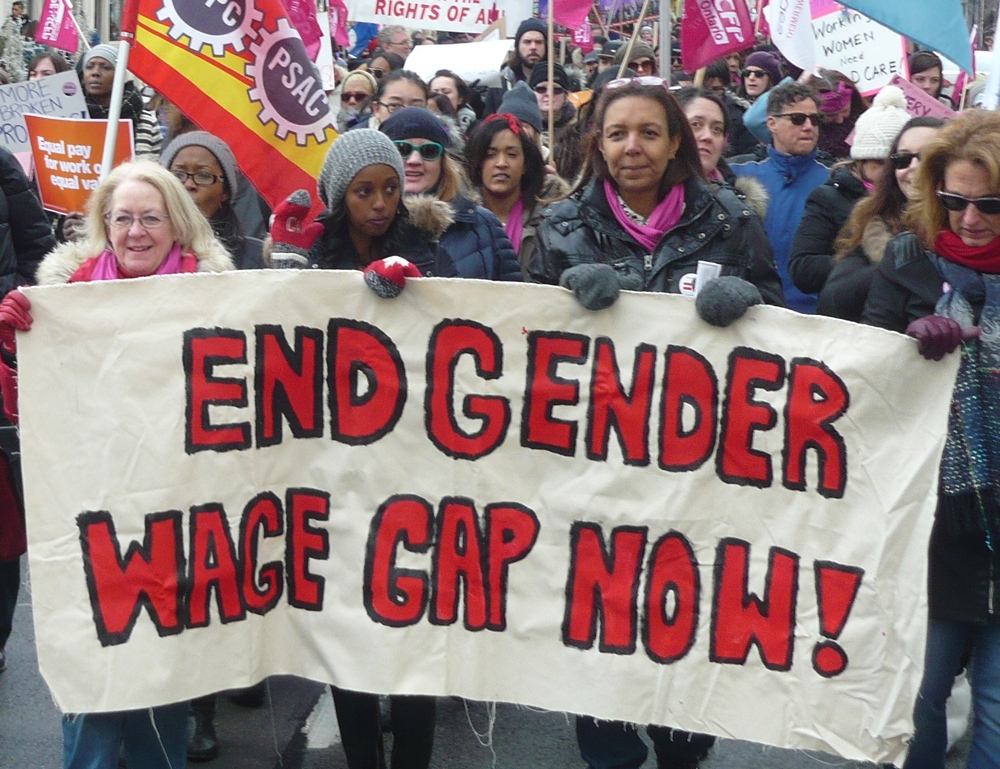 A 2015 UN Human Rights report
raised concerns about "the
persisting inequalities between women and men" in Canada,
including the "high level of the pay gap" and its
disproportionate effect on low-income women, visible minority
women, and Indigenous women.[1]
Out of 34 countries in the Organization for
Economic Cooperation and Development (OEDC), Canada had the
seventh highest "gender wage gap" (2014). A 2015 UN Human Rights report
raised concerns about "the
persisting inequalities between women and men" in Canada,
including the "high level of the pay gap" and its
disproportionate effect on low-income women, visible minority
women, and Indigenous women.[1]
Out of 34 countries in the Organization for
Economic Cooperation and Development (OEDC), Canada had the
seventh highest "gender wage gap" (2014).
Traditionally, Statistics Canada has used the annual
earnings
of full-time, full-year workers to measure the "wage gap" between
women and men. According to that metric, women aged 25 to 54
earned an average of $52,500 in 2014, while their male
counterparts earned an average of $70,700. Using this comparison,
women earned $0.74 for every dollar earned by men.
Women working at full-time jobs work fewer hours
annually
than men working at full-time jobs. If the "wage gap" is calculated
based on hourly earnings, women earned $.88 for every dollar
earned by men. Women earned an average hourly wage of $25.38,
while men earned an average hourly rate of 28.92.
Statistics Canada says that ratio has improved, in
part, due to rising educational attainment by women. A higher
percentage of women earn both post-secondary certificates or diplomas
and university degrees than men, but the "wage gap" persists. In 2015,
35.1 per cent of Canadian women had university degrees compared to 13.7
per cent in 1990.
Women are also penalized for their role in the
reproduction
of life. As mothers, they typically earn less than both women
without dependent children and fathers, and this "motherhood
penalty" persists over their working lives. Mothers with at least
one child under the age of 18 earned $0.85 for every dollar
earned by fathers, while women without children earned $0.90 for
every dollar earned by men without children.
Some provinces have entrenched specified minimum hourly
wages
for gendered work sectors, contributing to the "wage gap" between
men and women. For example in British Columbia, employees who
serve liquor, who are predominantly women, can be paid $1.25 less
than minimum wage. In New Brunswick construction labourers -- who
are predominately men -- have a required minimum wage that is $2.33
higher than the standard minimum wage.
Note
1. United Nations Office of the
High
Commission for
Human
Rights. "Concluding observations on the sixth periodic report of
Canada," 2015, p. 2.

Ruling Elite Continue Push for
Integration
and Continental Corridors for Trade
Rounds Six and Seven of NAFTA Negotiations
The working peoples of Canada, the
U.S. and Mexico
continue to lay
their claims for pro-social change under their
sovereign control
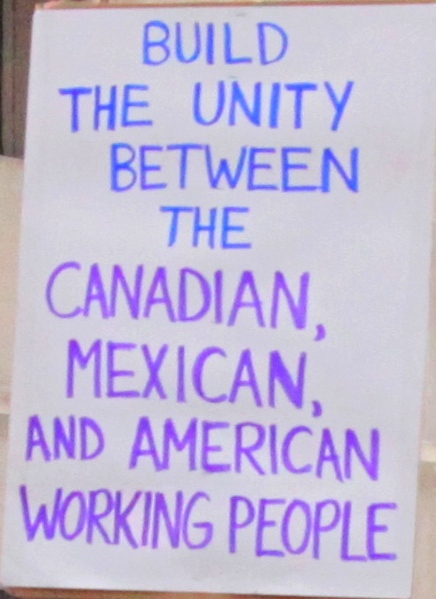 Round six of the NAFTA
negotiations took place
January 28 and 29 in Montreal. An impression is being created by
governments and the media in the service of the private interests
in control that "hope" now exists that the three parties which
claim to represent Canada, the United States and Mexico can "save
NAFTA." This deliberately hides who is negotiating what and in
whose interests. The working people of all three countries have
consistently said No! to free
trade under the control of the
narrow private interests of supranational big business. The
peoples do not want to save NAFTA; they have consistently opposed
monopoly-controlled free trade right from the beginning. The
peoples need nation-building projects based on self-reliant
economies under the control of those who do the work with a
modern aim to meet and guarantee the rights and well-being of all
and the general interests of society. Round six of the NAFTA
negotiations took place
January 28 and 29 in Montreal. An impression is being created by
governments and the media in the service of the private interests
in control that "hope" now exists that the three parties which
claim to represent Canada, the United States and Mexico can "save
NAFTA." This deliberately hides who is negotiating what and in
whose interests. The working people of all three countries have
consistently said No! to free
trade under the control of the
narrow private interests of supranational big business. The
peoples do not want to save NAFTA; they have consistently opposed
monopoly-controlled free trade right from the beginning. The
peoples need nation-building projects based on self-reliant
economies under the control of those who do the work with a
modern aim to meet and guarantee the rights and well-being of all
and the general interests of society.
All this chatter of NAFTA "progress" and "compromises"
is
meant to divert the working peoples of the three countries from
developing their own outlook independent of the will and views of
the ruling elite. The NAFTA negotiations are a farce. Right in
the middle of these talks, President Trump pronounced that trade
wars are good and winnable for the ruling elite he champions and
says large steel and aluminum tariffs are coming soon. This comes
on the heels of softwood lumber tariffs specifically targeting
Canadian production.
Trudeau and his foreign minister continue to dance to a
tune which caters to private interests seeking to dominate. The
international financial oligarchy linked to U.S. imperialism is clearly
striving to control the raw material and workers' capacity to work of
Canada, the U.S.and Mexico and integrate the economies of all three
countries into a war economy which will somehow rescue the moribund
U.S. economy writhing in crisis.
NAFTA is and always has been about strengthening the
power and control of the ruling elite who want continental integration
and corridors for trade, energy, security and transportation which
rescue U.S. imperialism in its striving to dominate the world. The U.S.
wants to have free movement of their police and military forces and
integrated regulations and decision-making so as to effectively pillage
and engage in destructive wars.
Within this aim, the oligopolies which comprise these
private interests are in open competition both in and outside NAFTA
negotiations. Conflict is their middle name. The ruling elite
constantly fight with each other and everyone over the right to exploit
the continent and world's raw material, expropriate the value workers
produce and lord it over all and sundry. They are in conflict with the
entire world; how else to explain the U.S. military's one thousand
bases outside the United States? They do not promote social love,
international unity, harmony, mutual benefit and development. They
destroy whatever they cannot control.
Secret Negotiations
These are secret negotiations.
The peoples are told only what the ruling elite consider serves
their plan for continental integration and the mass media are
willing accomplices. Reports claim that the sixth round of
negotiations "included a first significant back-and-forth
dialogue on autos and other major sticking points" and that
progress was made in this round as a result of "compromise
proposals" by Canada and Mexico on key U.S. demands. What does it
mean?
 Regarding "compromise proposals,"
Canadian
Press
reports that in response to U.S. demands to increase U.S. content in
produced autos, "Canada (our side) suggested new ways to
calculate whether a car counts as American. The new formulas
would inflate U.S. numbers somewhat by including areas where the
U.S. dominates, such as intellectual property and research. It
did not address U.S. demands for specific numeric targets for
parts production." Well isn't that sweet! We can fudge the
numbers and Trump will be happy. How does this move us forward
towards self-reliant steel, vehicle and machinery building
sectors that do not depend on what the financial oligarchs do or do not
want or consider good enough to make America great again? Regarding "compromise proposals,"
Canadian
Press
reports that in response to U.S. demands to increase U.S. content in
produced autos, "Canada (our side) suggested new ways to
calculate whether a car counts as American. The new formulas
would inflate U.S. numbers somewhat by including areas where the
U.S. dominates, such as intellectual property and research. It
did not address U.S. demands for specific numeric targets for
parts production." Well isn't that sweet! We can fudge the
numbers and Trump will be happy. How does this move us forward
towards self-reliant steel, vehicle and machinery building
sectors that do not depend on what the financial oligarchs do or do not
want or consider good enough to make America great again?
Meanwhile back in the world of autoworkers, they point
out
that this chatter hides the issue of intellectual property and
research on new technologies in autos, especially in the field of
artificial intelligence and self-driving vehicles. The U.S.
private interests are attempting to dominate their rivals in
these technologies for use not just in vehicle production but in
war and they aim to maintain absolute control.
Also, the talk about not addressing "specific targets"
for
vehicle parts production hides how the Canadian and U.S.
governments are already well advanced in preparing to place Canadian
auto parts plants under the jurisdiction of U.S. Customs. The
U.S. gets to inspect and clear what autoworkers produce at
Canadian factories for transport to the U.S. along secured
corridors, further expanding U.S. jurisdiction in Canada.
According to other reports, negotiators have now
finalized sections of a new NAFTA dealing with "anti-corruption,
competition and medium and small business." Canadians are not informed
what is behind this and cannot agree to anything finalized behind their
backs over which they have had no say. Governments have no mandate to
discuss let alone implement secret deals which do not favour the
peoples' interests.
The three parties have now reconvened in Mexico City to
continue their secret NAFTA talks of betrayal and sell-out to the
U.S. imperialist war machine.

Integration of Mexican, Canadian and
U.S. Regulatory Bodies
As a matter of a modern principle of nation-building,
regulations and standards should be a matter of sovereign public policy
and not determined by privileged private interests, which today are
globalized. That is not how the situation is viewed by the Trudeau
government or was viewed by previous governments since the late 1980s.
The Trudeau government is preoccupied with how to
integrate into a single institution the two Regulatory Cooperation
Councils (RCCs) established between Canada and the U.S. and the U.S.
and Mexico under the Harper government. Reports indicate that Canada
wants the RCC to become part of the North American Free Trade Agreement
but on a trilateral basis to include Mexico.
The existing U.S.-Canada RCC was established between
the
Harper and Obama governments in 2011. Its purported aim is
to "align" regulations between the two countries by integrating
regulatory bodies, eliminating existing regulatory differences
and establishing common regulations in new areas. It established
two Joint Action Plans that set out the direction for state
regulatory bodies of each country in almost all areas of the
economy.
In the U.S., the Canada-U.S. RCC is overseen by the
Office of
Information and Regulatory Affairs, a division of the White
House's Office of Management and Budget. In Canada it is overseen
by the Treasury Board.
Mexico and the U.S. have their own High-Level RCC,
which was
established in 2010. Mexico supports adding some form of an RCC
into NAFTA so long as it is trilateral. The U.S., however, "is
signaling a skepticism for a trilateral council and that
accepting it may require a power shift -- if rolled into NAFTA,
the council would move under the control of U.S. Trade
Representative (USTR) Robert Lighthizer's office. A Lighthizer
spokeswoman declined comment, while a business group that
initially backed the idea is now sounding an alarm by saying USTR
doesn't have the expertise to do this," Bloomberg News
reports.
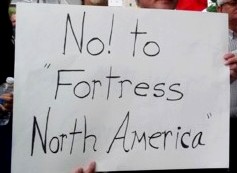 The controversy reveals that
the fight over the NAFTA
negotiations and what will be inside, outside or tweaked, and
whether it becomes bilateral or trilateral is being fought out by
contending private monopoly interests without any consideration
for the well-being and rights of the people. Who has authority
for the making of regulations and setting standards and with what
aim are fundamental matters of principle. Successive Canadian
governments have permitted Canadian regulatory powers to be
delegated and sub-delegated to private interests and foreign
powers to such an extent that regulations made in other countries
can de facto become the standard in Canada beyond any
control of Canadians. The controversy reveals that
the fight over the NAFTA
negotiations and what will be inside, outside or tweaked, and
whether it becomes bilateral or trilateral is being fought out by
contending private monopoly interests without any consideration
for the well-being and rights of the people. Who has authority
for the making of regulations and setting standards and with what
aim are fundamental matters of principle. Successive Canadian
governments have permitted Canadian regulatory powers to be
delegated and sub-delegated to private interests and foreign
powers to such an extent that regulations made in other countries
can de facto become the standard in Canada beyond any
control of Canadians.
Who sets standards for
health and safety at work, the
environment and anything else is a very important matter that
concerns the entire polity and the people's sovereign right to
decide and control those affairs that affect their lives. This
must be established within a sovereign state with modern
political forms that allow people to represent themselves. The
power to set standards must not be handed over to those
representing powerful private economic interests, domestic or
foreign.
Clearly, oversight of regulations affects the biggest
private interests, which is why various spokespeople for these
interests do not want oversight in the U.S. moved to the U.S. Trade
Representative. Maryscott Greenwood, chief executive officer at the
Canadian American Business Council, made up of representatives of the
biggest monopolies that operate in both countries and who have been
given decision-making power through the RCC, said pointedly: "Putting
it under USTR is not the right answer. This is not a place to resolve
disputes.... Our preference is to have the status quo on steroids. If
you can do that through NAFTA, terrific." Shifting the power to the
U.S. Trade Representative would "put the brakes on it."[1]
Eric Miller of the Rideau Potomac Strategy Group, also
a
"close observer of talks," said: "The preference would certainly
be to use NAFTA for what the private sector people hoped it would
be used for -- a way to make permanent, and bolster, the [Mexico-U.S.
Regulatory Cooperation Council], rather than the
opposite.... You're essentially taking it from the right
authority and expertise to make it happen, and handing it to the
people who have no authority and no expertise.... If the U.S.
business community really wants this, and the Canadian business
community really wants this, they've got to step up and let the
negotiators on all sides knows that this is a top priority and we
have to fight for it."[2]
Notes
1. The Board of the Canadian
American Business Council is
chaired by Christina Erling of Barrick Gold U.S.A. and Gary
Clement of TD Bank Group. Its members are:
Air Canada
Alcoa
Amazon
Amgen
Association of Canadian Ports
Association of Equipment Manufacturers
Association of Oil Pipelines
Bank of Montreal
Barrick Gold U.S.A.
Beauty Revolution
Bell Canada
Bennett Jones
BlankRome
Boeing
Bombardier
Borden Ladner Gervais
CAE
Campbell Soup Company
Capitol Hill Group
Canadian Trucking Alliance
Caterpillar
CIBC
Cisco
Clairvest Group Inc.
CNCoca Cola
Contextere
ConocoPhillips
eBay
Eli Lilly & Company
Enbridge
Energy and Equipment Infrastructure Alliance
ExxonMobil
Facebook
FedEx
Food & Consumer Products of Canada
Ford Motor Company
General Electric
General Mills
Google
Harley-Davidson Motor Company
International Council of Shopping Centers
John Deere Canada
Johnson & Johnson
Lockheed Martin
Mastercard
MDA
Motion Picture Association - Canada
Pfizer
PhRMA
Pitney Bowes
Privateer
Purdue Pharma
Red Bull
Rio Tinto
Shell Canada
Sun Life FinancialSNC-Lavalin Inc.
TD Bank Group
Tilray
UPS
2. In June, Eric Miller received
a contract from Industry
Canada to "come with a strategy on how to engage with American
politicians on trade." Miller previously worked as vice president
of policy, North America, and cyber security at the Business
Council of Canada. He has also been an Industry Canada employee at
the Canadian embassy in Washington, where his bio says he advised
senior staff "on U.S. economic, political, and technology
issues." iPolitics indicates that Miller "helped design Ottawa's
bailout package for the Canadian auto industry in 2009 and was
part of the negotiating team that created the Beyond the Border
Action Plan in 2011."

Control Over Energy Resources and Their Transport
Integration of the Canadian, U.S. and Mexican energy
infrastructure and resources under the control of the
U.S.-dominated energy monopolies is a major agenda item for the
NAFTA renegotiations. This issue is not generally discussed
publicly, as it reveals the extent to which those doing the
negotiating are moving quickly to place the energy resources of
the three countries under the control of the biggest private
interests to exploit, compete and wage war against global
competitors and further bring countries and regions they wish to
dominate, such as Venezuela, under their control. Regarding this
agenda item, disputes are not reported despite claims of
roadblocks and poison pills in NAFTA negotiations.[1]
 The Foreign Ministers of
the U.S., Mexico and Canada met in
Mexico on February 2. Energy integration was one of the main
topics discussed. In summarizing the discussions, Mexican
Secretary of Foreign Affairs Luis Videgaray Caso said
enthusiastically, "The North American region has the capabilities
in human and the natural resources to be a very clean energy and
cheap energy to be able to transform our societies and our
economies. We have agreed to keep on working with the work of our
secretaries. We also have the objective of getting regulations to
generate and create the synergies where we can have a mutual
construction of infrastructure, and of course, to enable the
private sector, which is going to be able to create projects not
only from hydrocarbons but also from the energy sector in clean
energies." The Foreign Ministers of
the U.S., Mexico and Canada met in
Mexico on February 2. Energy integration was one of the main
topics discussed. In summarizing the discussions, Mexican
Secretary of Foreign Affairs Luis Videgaray Caso said
enthusiastically, "The North American region has the capabilities
in human and the natural resources to be a very clean energy and
cheap energy to be able to transform our societies and our
economies. We have agreed to keep on working with the work of our
secretaries. We also have the objective of getting regulations to
generate and create the synergies where we can have a mutual
construction of infrastructure, and of course, to enable the
private sector, which is going to be able to create projects not
only from hydrocarbons but also from the energy sector in clean
energies."
U.S. Secretary of State Rex Tillerson echoed his
remarks
stating, "North America is also a major player, as Secretary
Videgaray highlighted, in the energy markets. And we discussed
what we believe are really unique opportunities to promote
market-based energy development and to further energy integration
throughout North America and the hemisphere."
Later on February 5, U.S. Ambassador to Canada Kelly
Craft
said, "The United States wants NAFTA modernization to strengthen
the North American energy revolution and promote North American
energy security and self-sufficiency.... A separate energy
chapter must add value not duplicate obligations found in other
chapters."
Note
1. An example of how the prevailing
reporting on the NAFTA negotiations hides significant
developments in the integration of energy transport under private
control, it was reported on January 25 that Hydro-Quebec signed a
20-year energy export contract with Evercore, a large
international "investment banking firm" specializing in mergers
and acquisitions for the state of New Hampshire. The contract is
reportedly the biggest export agreement in Hydro-Quebec's
history. The contract requires the construction of "the Northern
Pass," which involves a 192-mile transmission line to be built
linking Quebec's electricity to that of New Hampshire. Control
over export levels and pricing of this electricity will no doubt
come under a newly-negotiated NAFTA or bilateral arrangement.

Push for Trade Corridors Under U.S. Control

Demonstration by maritime workers against Bill C-23, Vancouver,
December 16, 2017.
Bill C-23 An Act respecting the preclearance of
persons
and goods in Canada and the United States received Royal
Assent on December 7. The legislation expands "preclearance" -- a
process for clearing customs of the destination country before
leaving the country of origin, from select airports in Canada to
land and water crossings. It permits preclearance of cargo in
Canadian facilities by U.S. agents, and authorizes them to carry
weapons and detain, search and use force against Canadians within
preclearance zones where U.S. agents are permitted to operate.
How to implement the expanded powers and presence of U.S. agents
in Canada and the possibility of placing Canadian agents in the
U.S. is now being sorted out.
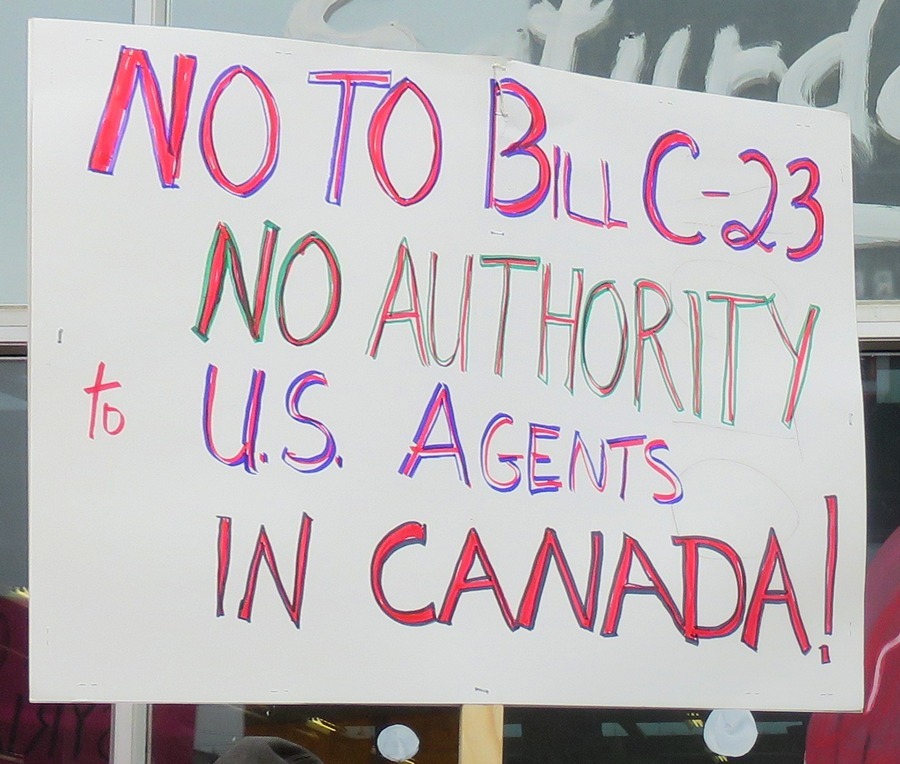 On February 5, Canada's
Minister of Public Safety Ralph
Goodale met with U.S. Homeland Security Secretary Kirstjen
Nielsen. Preclearance was a main item on the agenda. The Canadian
Press wrote: "Imagine clearing Canadian customs
in Florida, Arizona, or Chicago, or having a U.S. customs
facility attached to a car plant in Ontario, with the goal of
helping people and cargo travel faster between the countries. The
Canadian and American governments are discussing it." On February 5, Canada's
Minister of Public Safety Ralph
Goodale met with U.S. Homeland Security Secretary Kirstjen
Nielsen. Preclearance was a main item on the agenda. The Canadian
Press wrote: "Imagine clearing Canadian customs
in Florida, Arizona, or Chicago, or having a U.S. customs
facility attached to a car plant in Ontario, with the goal of
helping people and cargo travel faster between the countries. The
Canadian and American governments are discussing it."
Goodale said during a press conference that he
envisions a
future where cars can have their components screened and sealed
for shipment right inside the plant. He suggested that given a
car under construction might cross the border a half-dozen times,
preclearance would avoid snags and boost productivity. "The real
prize of preclearance is when we could expand it from passenger
to cargo," Goodale said. He is referring to a system whereby
Canadian factories house U.S. preclearance zones within them to
"clear" cargo for shipment by rail, air, truck or ship to and
from the U.S.
The routes by which this cleared cargo is shipped will
also
become
subject to U.S. national security laws and powers to "ensure"
that goods are not tampered with. Thus preclearance in a factory
is part and parcel of establishing corridors for the shipping of
goods in Canada under U.S. control. Such corridors are already
being established; however, now no doubt it will be helped along
with new self-serving justifications.
Revealing that both U.S. and Canadian governments are
on the
same page for such an arrangement, Goodale said: "You've got an
administration on the American side and certainly on our side,
that really want to move these files."
The Liberal government gleefully boasts of seeking to
place customs agents in Canada with broad powers to violate workers'
rights. Such a proposal has been one of the main demands of the auto
monopolies. In particular, in 2006 it was floated by auto parts magnate
and Magna CEO Frank Stronach. While not new, the Trudeau government has
now made the project its own with its legislation, while hiding what
such a project and this legislation will really mean for Canadians.
Maritime workers at the port of Vancouver have taken up
the
fight to affirm their rights as Canadian workers in the face of
any attempts to give U.S. security agencies the right to decide
who can and cannot work in Canadian ports.
Clearly autoworkers, especially those working in the parts sector must
prepare themselves and make it clear that they too will not accept
their workplaces and their working lives being placed under the control
of U.S. Homeland Security. Just as autoworkers do not accept their
company owners or their own governments violating their rights, they
are called upon now to stand firmly in opposition to any attempts to
violate their rights in the name of securing the transport of goods
across the Canada-U.S. border.

Justice for Missing and Murdered
Indigenous
Women
Cross-Canada Actions Demand
Justice for Tina Fontaine

Tina Fontaine was a 15-year-old Indigenous youth who
was
murdered in Winnipeg in August 2014 and her body dumped in the
Red River. Tina was from the Sagkeeng First Nation, located along
the southern part of Lake Winnipeg, about 120 kilometres north of
Winnipeg, where she was raised by her great aunt and uncle Thelma
and Joseph Favel.
In June 2014, Tina's great aunt Thelma gave her
permission to
go to Winnipeg to reconnect with her biological mother. When
Thelma did not hear from Tina, she contacted Child and Family
Services (CFS) who took Tina into care. Tina was housed by CFS at
the Best Western Hotel in Winnipeg, but was reported missing on
August 9, 2014.
After being reported as "missing" from CFS care, Tina
was
seen by police, and was in contact with paramedics, security
officers and staff at the Winnipeg Children's Hospital, yet she
was not taken back into care. Her body was pulled from the Red
River on August 17, 2014. A suspect, Raymond Cormier, then in his
early fifties, was seen with Tina before she disappeared and was
later arrested and charged with second-degree murder, based on
circumstantial evidence and recordings made from bugs planted in
his apartment. In the recordings, Cormier never admitted to
killing Tina. He did admit to having sex with her, i.e.,
committing statutory rape (in 2008, the Harper government raised
the age of consent from 14 to 16 years of age). Unbelievably, the
prosecution's charge of second-degree murder against Cormier was
based on its theory that Tina threatened to report him for
statutory rape, yet it never brought any rape charges against
him, despite having his confession on tape! Cormier was acquitted
of second-degree murder on February 22.
The immediate aftermath of Tina's murder was yet
another
galvanizing moment in the people's demands for a national inquiry
into missing and murdered Indigenous women and girls. Thousands
of people marched in the streets of Winnipeg and an encampment
took place for weeks at the Manitoba Legislature. Tina's family
and Indigenous leaders decried the racism and neglect of
authorities and social services toward Indigenous youth, a
problem that exists across the country. While failing to convict
someone of murder based on circumstantial evidence is not
surprising, the authorities' silence on the statutory rape of Tina
Fontaine by Raymond Cormier, is a matter of profound concern. It is
nearly three years after Cormier was recorded admitting to the crime.
This silence and failure to convict underscores the accusations of
racism, neglect and genocide that surround Tina's disappearance and
death. Cormier's acquittal thus aggravated the
open wounds of the racist treatment of Indigenous peoples by
Canada's judicial and social services systems, leading to an
outpouring of anger, sadness and remembrance for Tina's life
being cut short, along with the thousands of other missing and
murdered women and girls across Canada.
Posted below are photos from the ongoing actions across
Canada that began on February 23 to remember Tina Fontaine and to
demand justice for her mistreatment and death.
Vancouver; Victoria
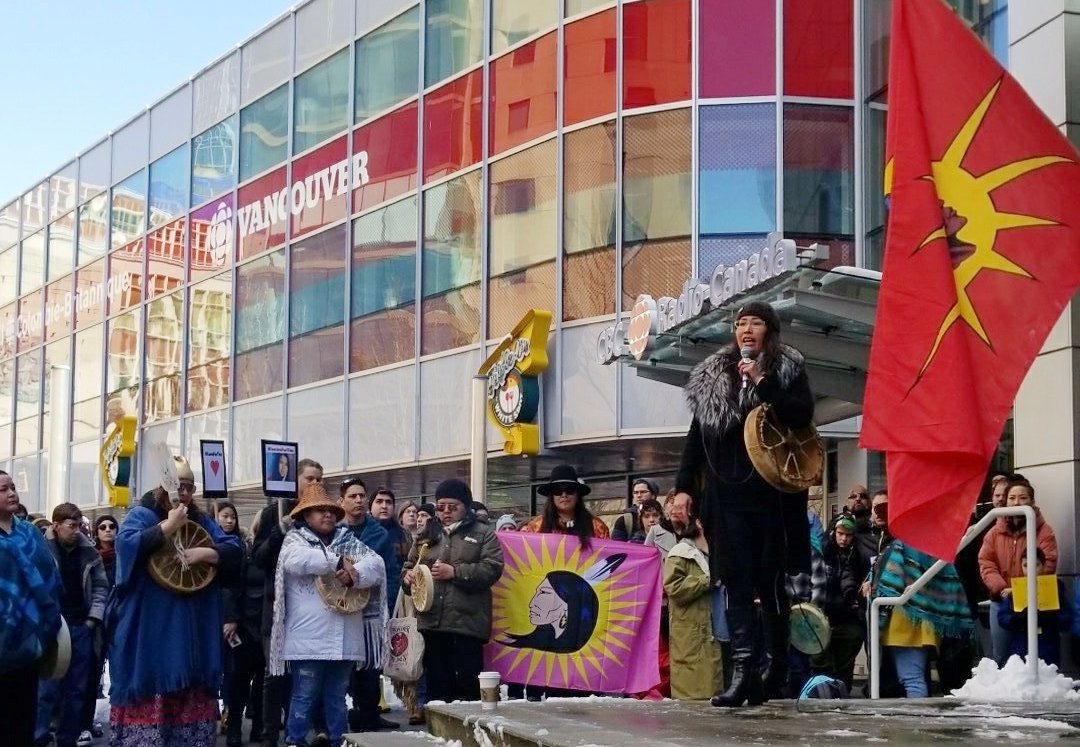 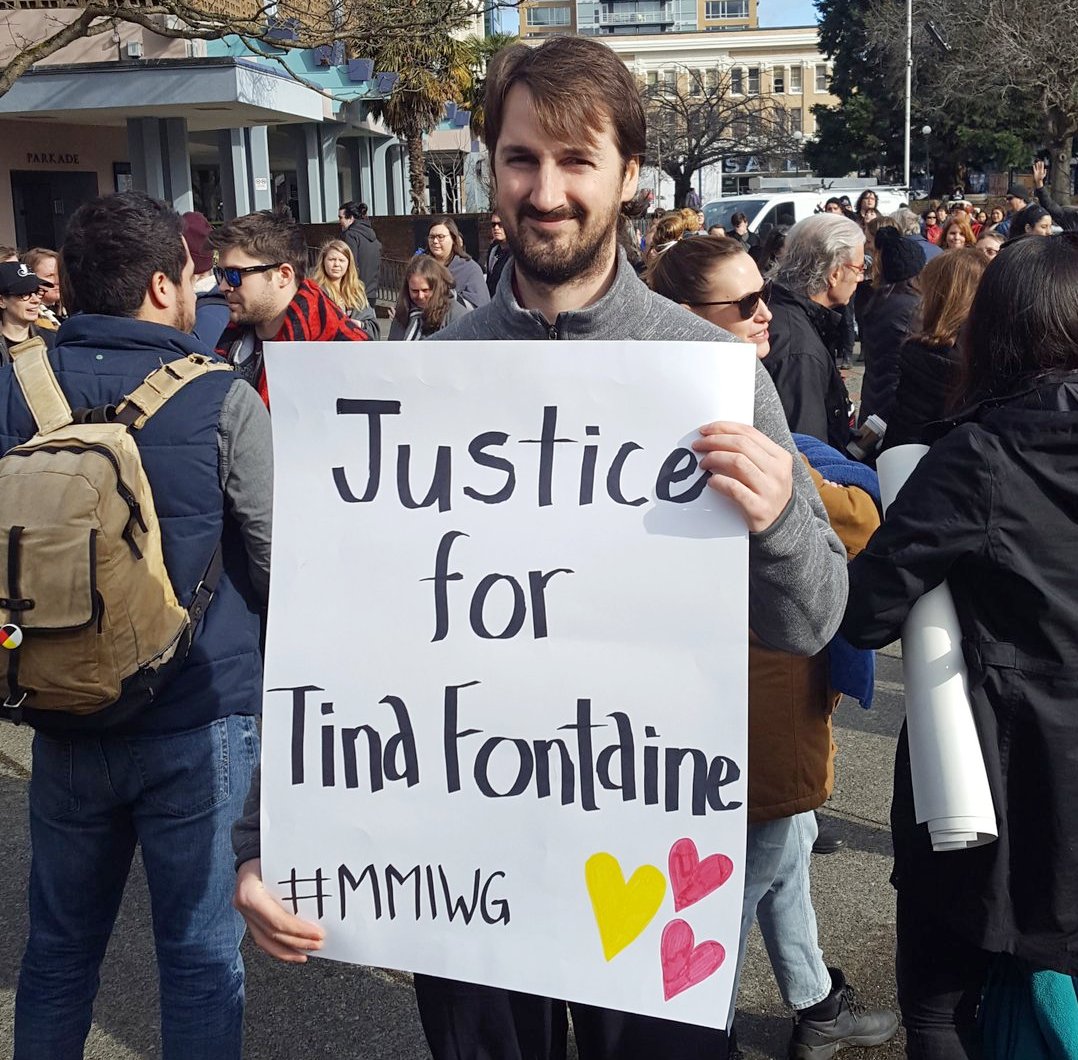
Prince George

Penticton

Calgary
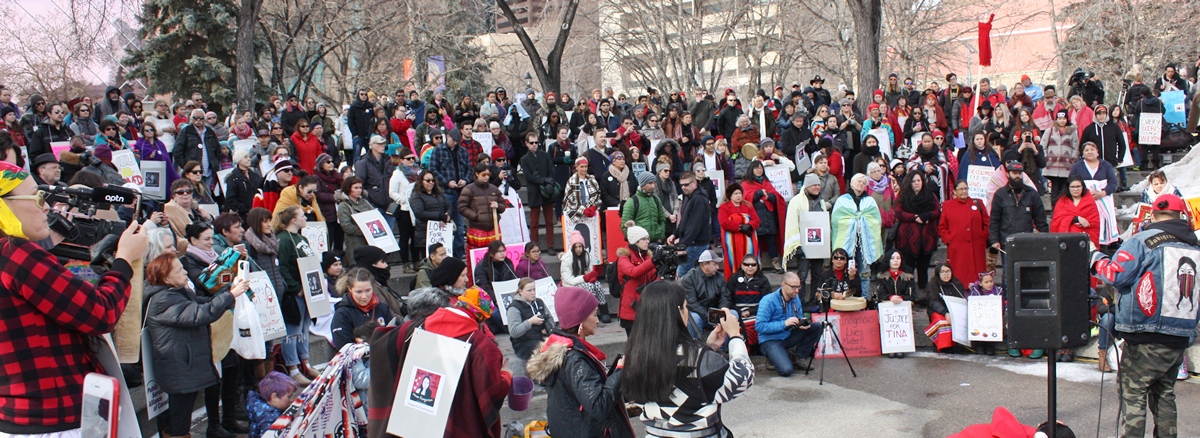
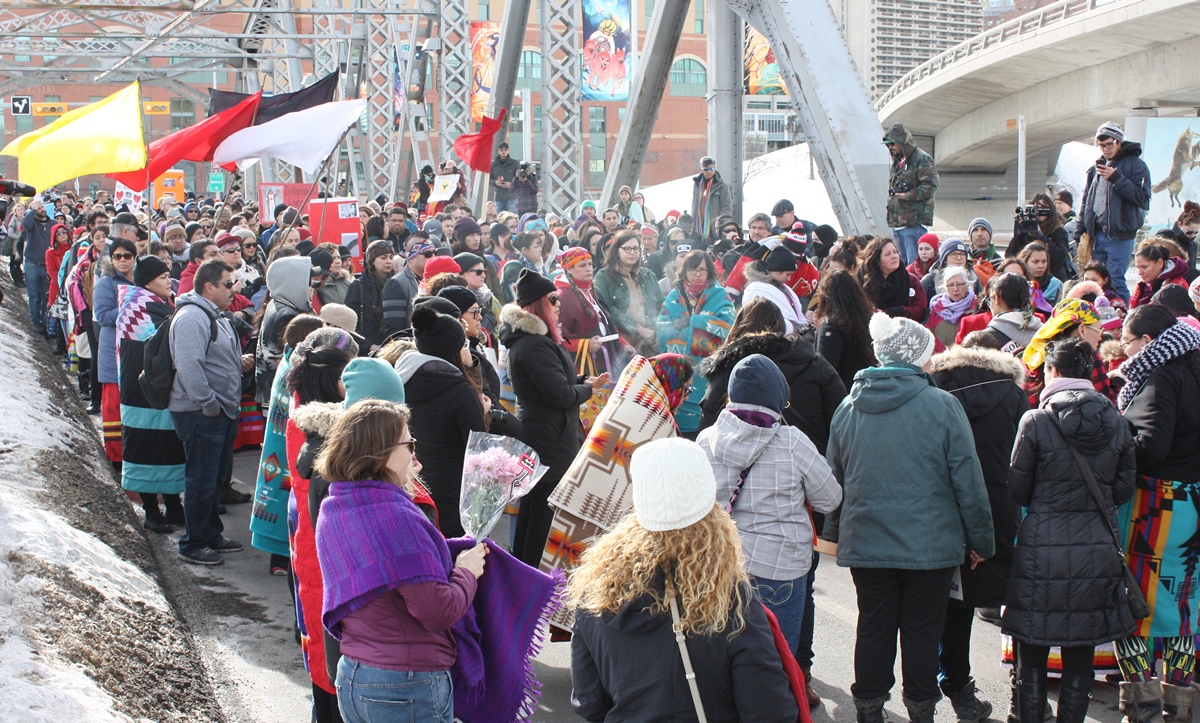 
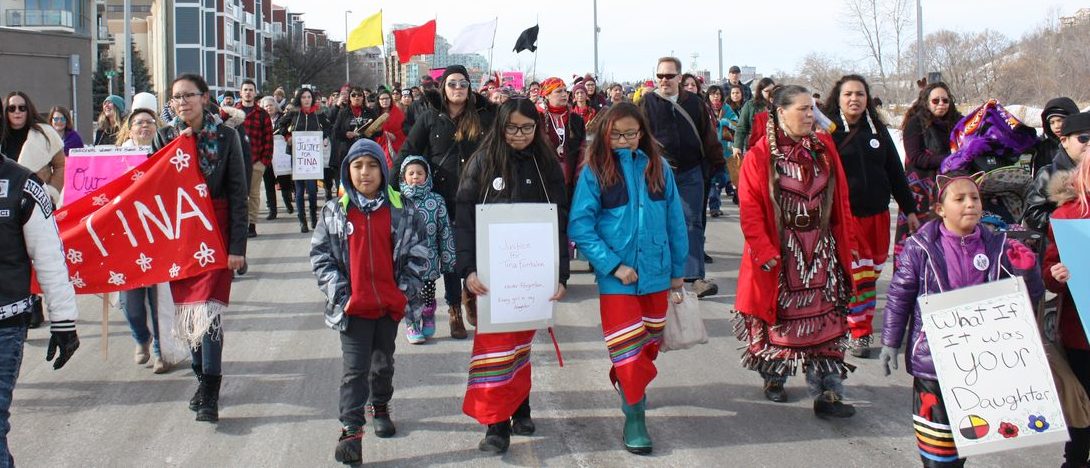
Edmonton

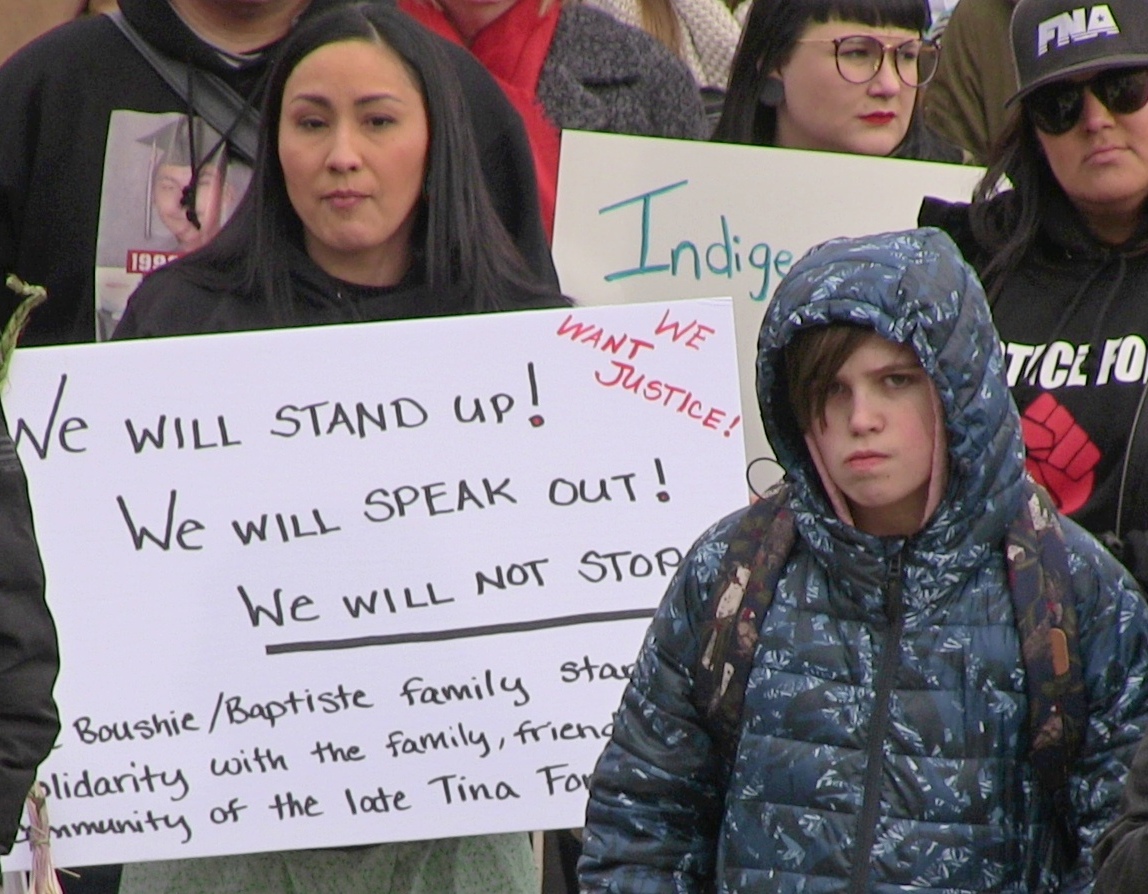 
  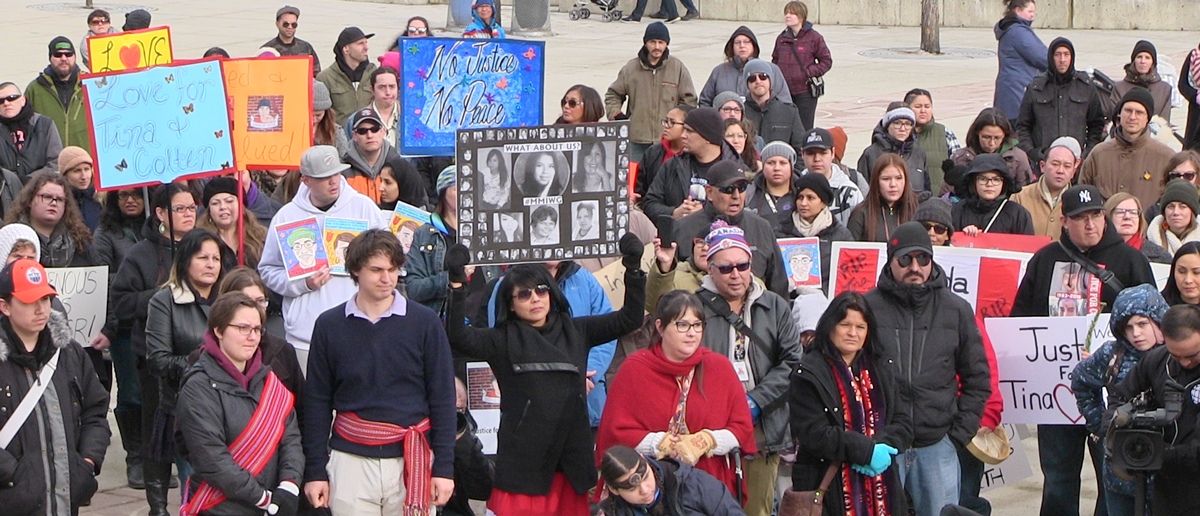
Regina
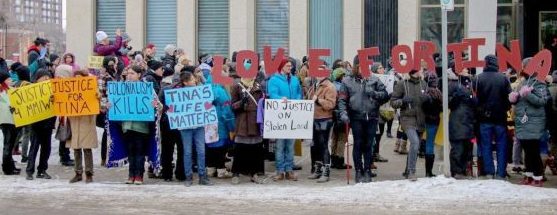
Winnipeg



Thunder Bay

 
Sudbury
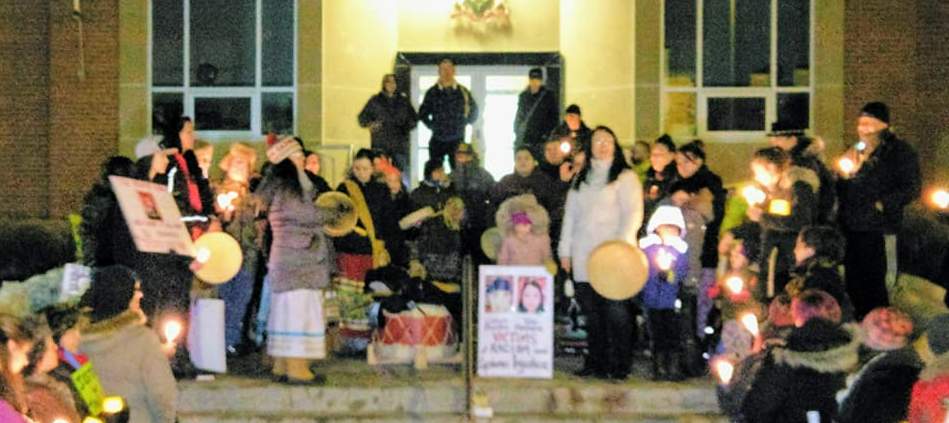

Windsor

Guelph

Toronto

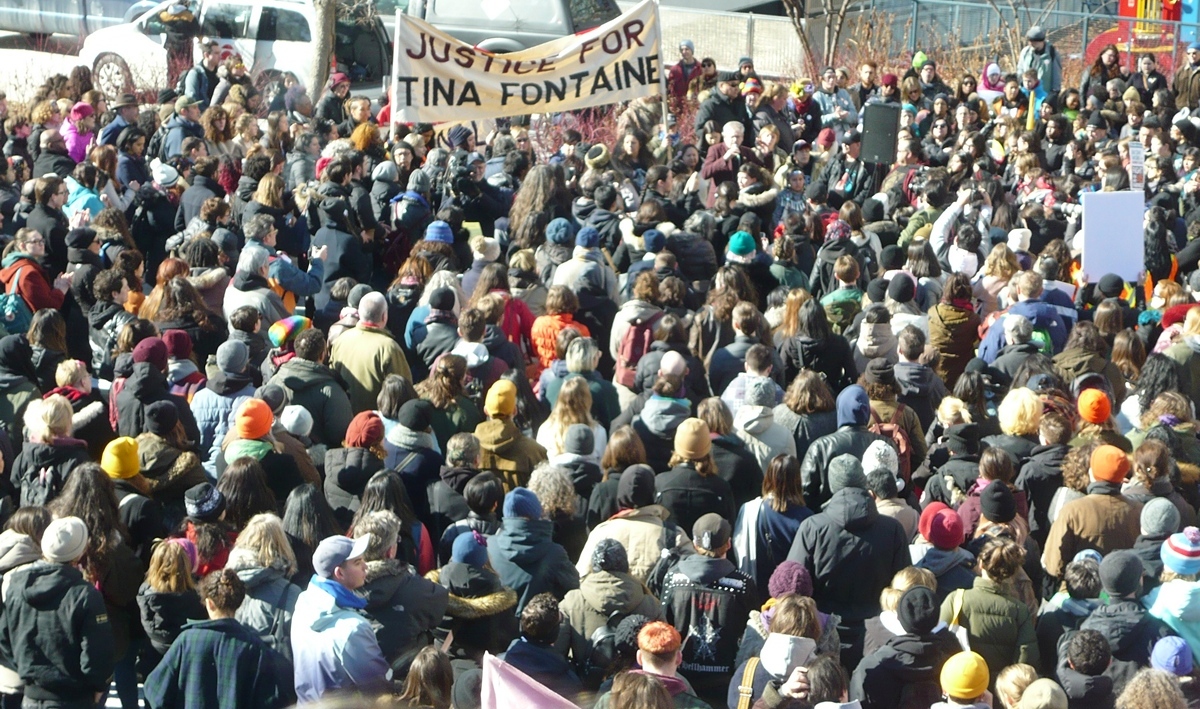
Ottawa

Montreal
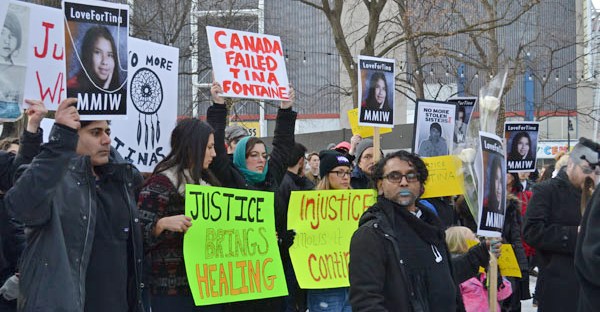
Halifax
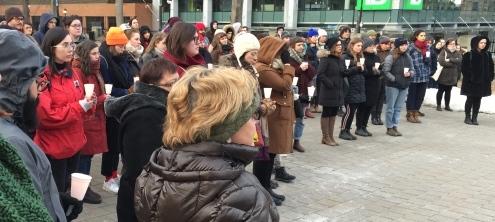
Fredericton


Walking with Our Sisters Mnidoo Kweok Exhibit
Visits Sudbury
and Kenora
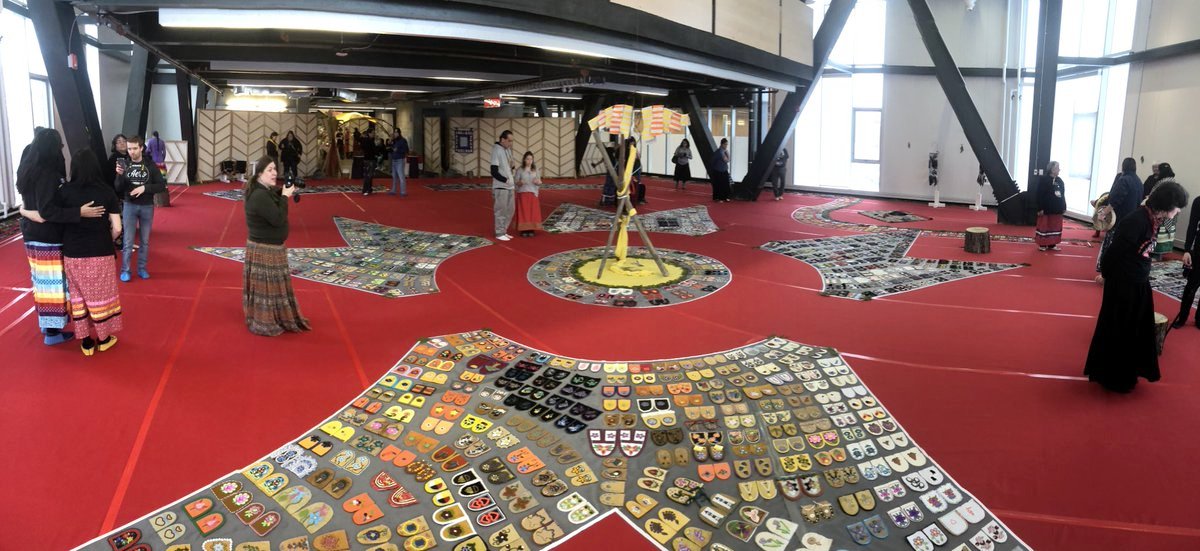
Walking with Our Sisters exhibit in Sudbury.
The Walking With Our Sisters Mnidoo Kweok Gathering 2018
is a commemorative art installation that is being exhibited in Sudbury
and Kenora in Northern Ontario this winter. Eighteen hundred and eight
pairs of moccasin vamps (tops) have been created and donated by
hundreds of caring and concerned individuals to draw attention to the
injustice of missing and murdered Indigenous women. Walking With Our
Sisters began in 2012 when Métis artist and author Christi
Belcourt organized a call-out, asking people to decorate the tops of
moccasins. She was hoping to get 600 vamps. She received seventeen
hundred and sixty-three pairs of moccasins. The response from people
was an outpouring of love and care from all over the world and from all
walks of life. Each pair of vamps represents one missing or murdered
Indigenous woman. An additional one hundred and seventeen children's
vamps were added in May of 2014 during a ceremony at the site of the
old Shingwauk Residential School in Bawating (or Sault Ste. Marie) to
honour and commemorate the lives of children who never returned home
from the schools.
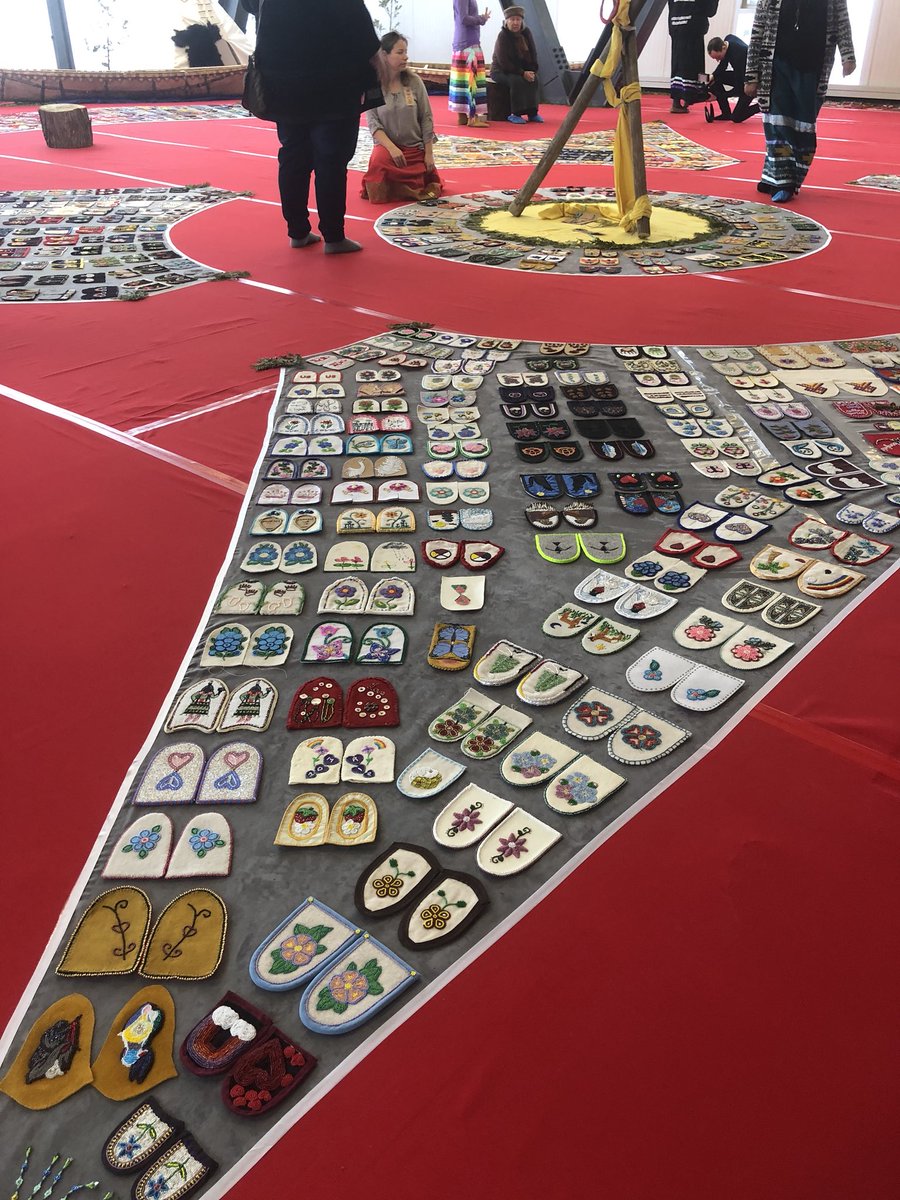 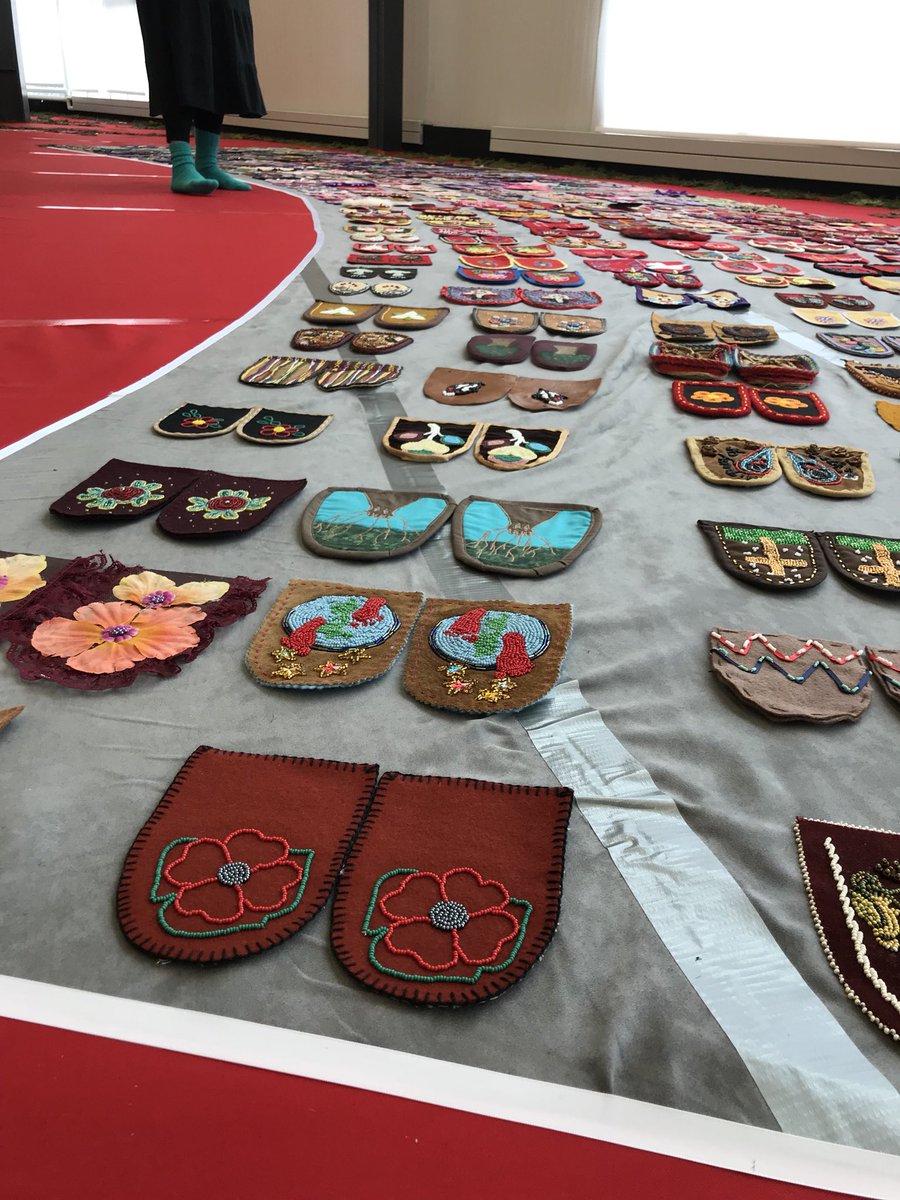 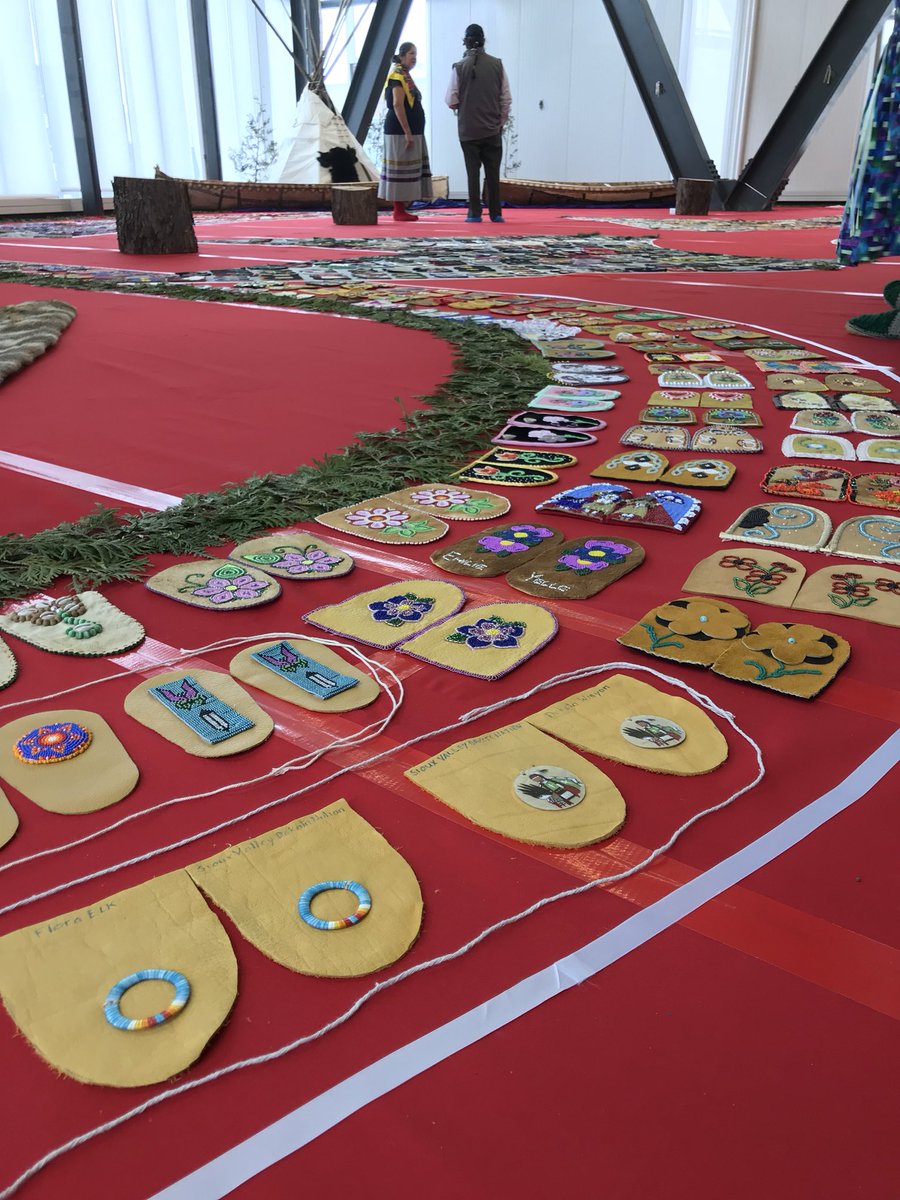
Sudbury exhibit.
This Walking With Our Sisters Sacred Bundle of over
2,000 pairs of vamps visited the McEwan School of Architecture in
Sudbury from January 7-17 and continued its journey to the next
installation in Kenora, Ontario where it was available for viewing by
the public at the Day's Inn from February 4-14.
 The exhibit follows traditional
Indigenous ceremonial protocols. The work exists primarily as a floor
installation made up of the beaded vamps arranged in a winding path
formation on fabric. Viewers remove their shoes to walk on a path of
cloth alongside the unsewn vamps. The unfinished moccasins represent
the unfinished lives of the women and girls who have been murdered or
who are still missing. The women have been cared for; they have been
loved; they are missing; they are missed; they are not forgotten. More
than 3,000 people visited the exhibition over the ten days that the
commemoration was open to the public. The exhibit follows traditional
Indigenous ceremonial protocols. The work exists primarily as a floor
installation made up of the beaded vamps arranged in a winding path
formation on fabric. Viewers remove their shoes to walk on a path of
cloth alongside the unsewn vamps. The unfinished moccasins represent
the unfinished lives of the women and girls who have been murdered or
who are still missing. The women have been cared for; they have been
loved; they are missing; they are missed; they are not forgotten. More
than 3,000 people visited the exhibition over the ten days that the
commemoration was open to the public.
"Our committee is very honoured and proud to have the
opportunity to invite our community to the School of Architecture to
build this Lodge, and to look after it for these ten days. We hope that
the community had an opportunity to feel the love in the Lodge and for
reflection and healing, said Dana Hickey, co-lead of the Walking With
Our Sisters Sudbury planning committee.
"I believe that Walking With Our Sisters Sudbury has
been an opportunity for volunteers to gather strength working together
in cooperation to affect change in their community. Rather than seeing
this as being an ending, I see this as the beginning of many voices
coming together to carry forward the essence of what Walking With Our
Sisters has become. This has touched the community organizers in a way
that has built spiritual strength and unified their beliefs about what
can be achieved through common ground," said Maggie Cywink.

Volunteers at the Sudbury exhibition.
Walking With Our Sisters is a national project that has
been supported by thousands of Indigenous and non-Indigenous women and
men across the country. It is rooted in the four principles of love,
humility, protocol and volunteerism, and guided by local Elders and
community members. "Gchi-miigwetch to the community of Sudbury, the
volunteers and the firekeepers who helped make this beautiful star
lodge. Miigwetch to the National Collective for bringing this Sacred
Bundle to us and for the many gifts this lodge has brought to our
community while it was here," said Juanita McNichol, Ceremonial Lead
Grandmother to the Walking With Our Sisters Sudbury installation.
"This has been very educational for our school groups
and for our young people, as well as for non-Indigenous visitors who
came to learn about the issue of missing and murdered Indigenous women,
girls and Two-Spirit people. I am very proud of our Grandmothers for
bringing those good teachings to the young people about how to take
care of themselves in that good way. These Spirits that are here thank
you for walking with them, and for the compassion expressed by all
walks of life as they come through the doors," said Walking With Our
Sisters Grandmother Martina Osawamick.
|
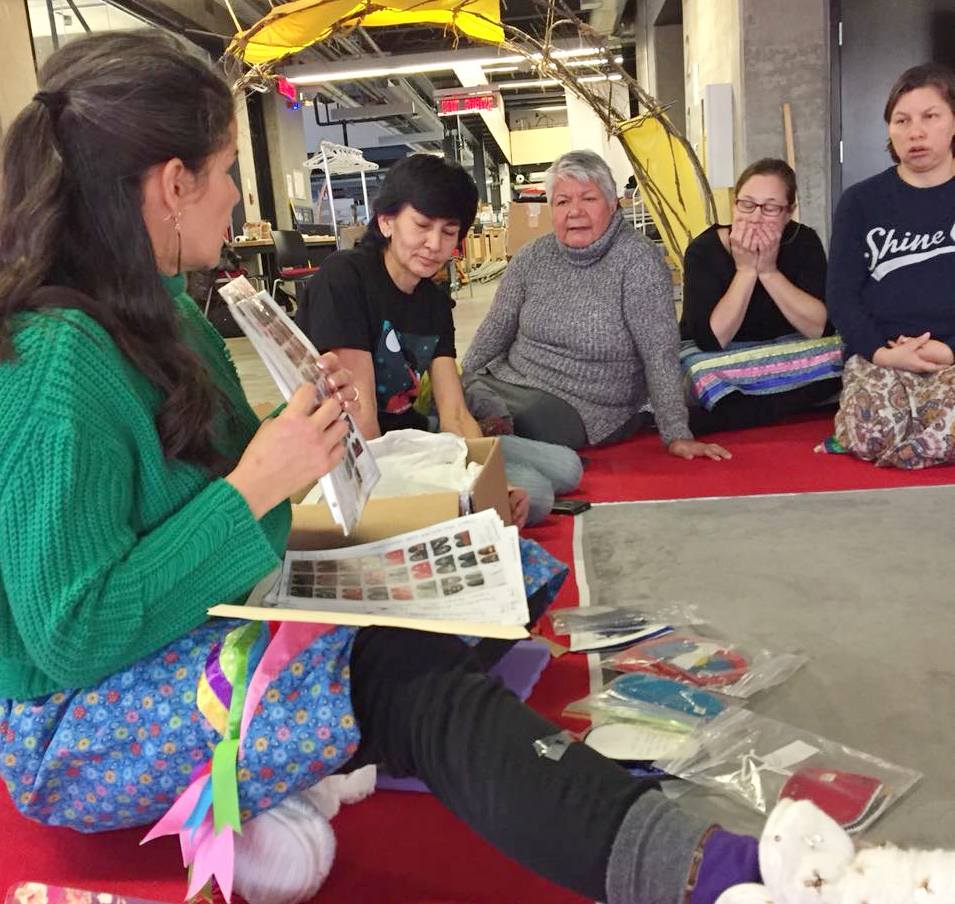
Grandmothers preparing the exhibit.
|
"The Grandmothers are the torch bearers that keep that
light going and keep our communities going. This memorial helps our
visitors to gain a better understanding about these issues that face
our people, and when we visit and talk with our visitors we get a
better understanding about them. This helps our relationships with
other people. We are one big family regardless of our differences,"
said Hilda Nadjiwan, a Walking With Our Sisters Grandmother.
"I am happy to see the way that everyone embraced their
roles and came together as a family so that the last ten days ran
smoothly. I acknowledge the youth who visited from the schools, and the
rest of our visitors as well. I hope they leave with a good heart and a
good mind and a new understanding about our Anishinaabe culture. I want
to acknowledge the stories that have come with the visitors, and I hope
that they take good stories away with them. It is the sharing of these
stories that makes this experience educational. I want to acknowledge
everyone who donated so that we could feed our volunteers and make this
important work possible. I want to express my love for everyone and for
creation, miigwetch," said Julie Ozawagosh, another Walking With Our
Sisters Grandmother.
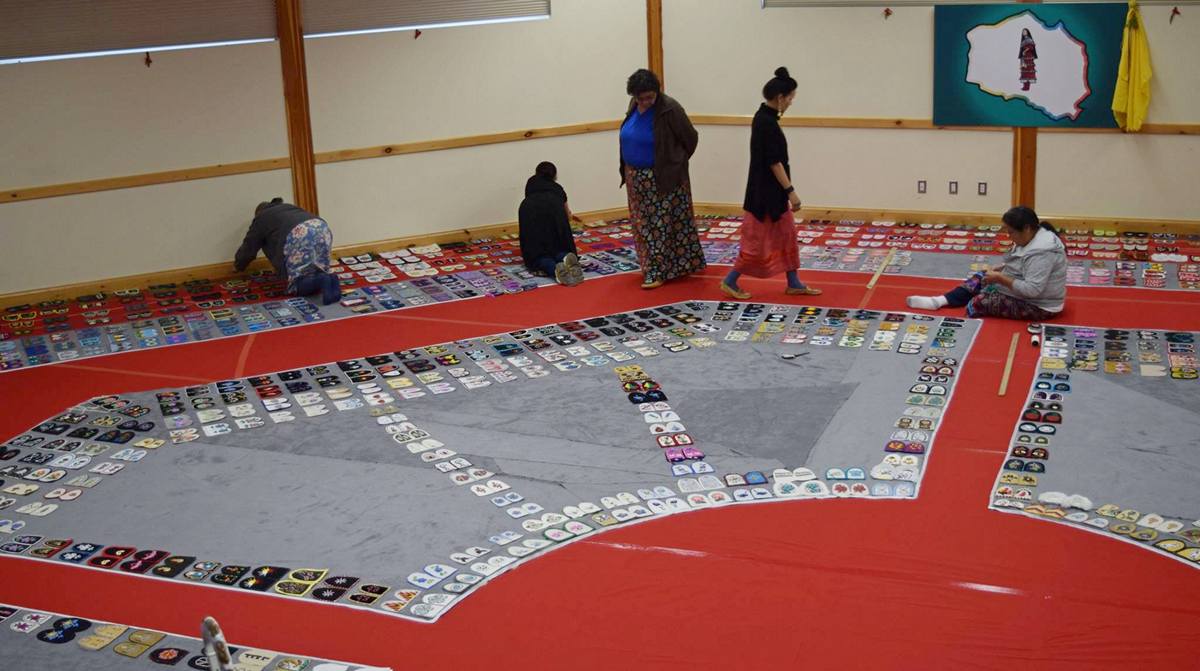
Setting up the exhibition in Kenora.

Robinson Huron Treaty Annuities Hearings
in Sudbury
Anishinaabek People Oppose Liberal Hypocrisy
and Fight For
Treaty Rights
- David Starbuck -

Legal team for Robinson Huron Trust First Nations, Red Rock and
Whitesand First Nations, Canada, and Ontario, with Justice Patricia
Hennessy and the Elder witnesses and some citizens at court in Garden
River First Nation.
On March 5th, hearings in the Robinson-Huron Treaty
Annuities Case resume at the Radisson Hotel in Sudbury
to hear final arguments and for the rendering of a decision. The
Anishinaabek communities of the Robinson-Huron Treaty have taken
Ontario and Canada to court over the Crown's failure to implement
the terms of the treaty. At issue is the fact that the
beneficiaries have received no increase to the four-dollar per
person annuity since 1874, despite the financial profits derived
from the land that the Canadian and Ontario governments have been
enjoying for over 140 years.
|

Ceremonial Teepee in Sudbury
|
Starting on September 25, 2017, hearings were held at
the
Court House in Thunder Bay, Ontario, at the Manitoulin Hotel and
Conference Centre in Little Current and at the Community Centre
in Garden River First Nation near Sault Ste. Marie, the site of
the Treaty signing in 1850. The court then moved to the Radisson
Hotel in Sudbury in November where it has heard and will hear all
the remaining witnesses. At each of the locations, pipe and sweat
lodge ceremonies are held. Teepees have been erected and a sacred
fire lit which will burn for the duration of the trial. Elder
Leroy Bennett has been coordinating the cultural events at each
of the locations. Mishomis Clifford Waboose and his firekeepers
have been tending the sacred fire. Justice Patricia Hennessy and
all of the lawyers from the Anishinaabek legal team, and Canada's
and Ontario's teams have participated in the ceremonies.
The Anishinaabek territory contained within the
Robinson-Huron Treaty area includes approximate 35,700 square
miles of land on:
[...] the eastern and
northern shores of Lake
Huron from Penetanguishene to Sault Ste. Marie, and thence to
Batchewanaung Bay on the northern shore of Lake Superior,
together with the islands in the said lakes opposite to the
shores thereof, and inland to the height of land which separates
the territory covered by the charter of the Honorable Hudson's
Bay Company from Canada, as well as all unconceded lands within
the limits of Canada West to which they have any just claim."
The Robinson-Superior Treaty covers approximately 16,700
square miles on:
[...]the Northern Shore of
Lake Superior, in the
said Province of Canada, from Batchewana Bay to Pigeon River, at
the western extremity of said Lake, and inland throughout that
extent to the height of land which separates the territory
covered by the charter of the Honorable the Hudson's Bay Company
from the said tract, and also the Islands in the said Lake within
the boundaries of the British possessions therein."
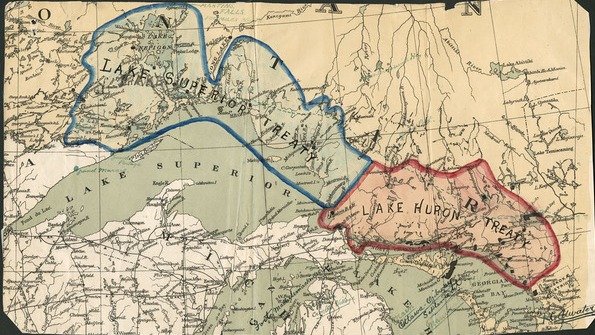
Historical map showing territories included in both Robinson-Huron and
Robinson-Superior Treaties
The Robinson-Huron Treaty case, which is being heard in
conjunction with another case involving the Robinson-Superior Treaty,
concerns the interpretation of an annuity "augmentation" clause, common
to both the Robinson Treaties, signed in 1850. The clause provides for
the increase of annuities paid to the First Nations under the treaties,
if resource revenues allow for such an increase without incurring a
loss:
The said William Benjamin
Robinson, on behalf of Her Majesty, Who desires to deal liberally
and justly with all Her subjects, further promises and agrees
that should the territory hereby ceded by the parties of the
second part at any future period produce such an amount as will
enable the Government of this Province, without incurring loss,
to increase the annuity hereby secured to them, then and in that
case the same shall be augmented from time to time, provided that
the amount paid to each individual shall not exceed the sum of
one pound Provincial currency in any one year, or such further
sum as Her Majesty may be graciously pleased to order; and
provided further that the number of Indians entitled to the
benefit of this treaty shall amount to two-thirds of their
present number, which is fourteen hundred and twenty-two, then
the said annuity shall be diminished in proportion to their
actual numbers.
The Robinson-Superior Treaty contains a
virtually identical clause which differs only in population
numbers applicable.
The wealth generated from the watersheds of Lake Huron
and
Lake Superior is extensive. Elders of Atikameksheng Anishnaabek
First Nation, whose traditional territory includes the Sudbury
Basin, estimates that the wealth extracted from its traditional
territories is more than $550 billion. It is said that the silver
of Cobalt, which accounted for one-eighth of the world supply and
which lies within the territory of the Robinson-Huron Treaty,
built Toronto's Bay Street, in the first years of the last
century.
The court heard from all of the Anishinaabe Elders and
experts on Anishinaabe law, oral history and ceremonies. Expert
witnesses included Jim Morrison, Alan Corbiere, Heidi Bohaker,
Heidi Stark, Fred Kelly and Carl Beal. These people presented the
history and traditional Anishinaabe law and governance
surrounding the making of the Treaty in the 1800s. Elder
witnesses who presented evidence on the understanding of the
Anishinaabe of the treaty in the language of the Ojibway in 1850,
the Anishinaabe law, way of life and governance at the time of
the Treaty-making were Ogimaa Duke Peltier, Rita Corbiere, Ogimaa
Dean Sayers, Irene Stevens, Angus Toulouse and Irene
Makadebin.
In January and February, the Canadian and Ontario
governments
presented their defence. Their argument centres around the
provision in the Robinson Treaties for an increase "without
incurring a loss." The governments are arguing that the fact
that the governments are in deficit means that they cannot
provide an increase in the annuity "without incurring a
loss." As the Anishinaabek lawyer said "Well, as I
understand it, my friend (Crown) is arguing that, based on this
evidence, Ontario has the right to spend money on whatever it
wants to in the territory and that is going be deducted from the
amount available for the Anishinaabe."
By the time of the signing of the Robinson Treaties in
1850,
the British colonialists had signed treaties covering most of
Southern Ontario and settled them. They were looking for more
land for colonization and, in particular, they eyed the timber and
mineral resources of the Lake Huron and Lake Superior watersheds.
With the discovery of copper in the Keewatin peninsula in upper
Michigan, the pressure to open up these lands to capitalist
exploitation was intense.

Drawing of the Bruce mines, 1870.
|
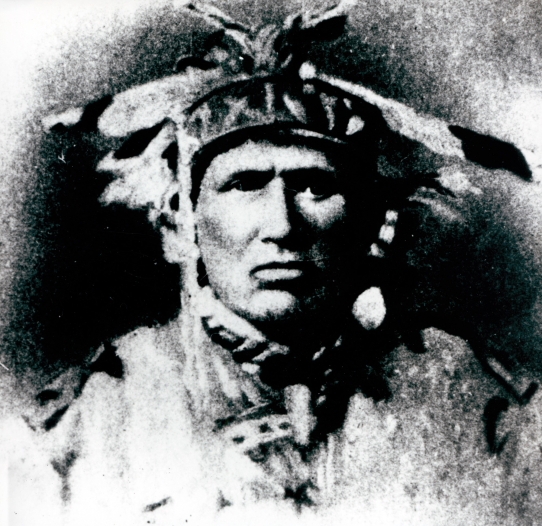
Chief
Shingwaukonse of Bawaating.
|
Mining operations began in Bruce Mines,
on the north shore of Lake Huron, and Mica Bay, on the north-east
shore of Lake Superior. These mining operations were extremely
deleterious to the traditional ways of the Indigenous people.
Surrounding land was denuded of timber to support the mines and
smelting operations, noise and fumes poisoned the atmosphere and
game was driven away. The situation was such that Chief
Shingwaukonse of Bawaating (Sault Ste. Marie) and a group of
between 30 and 100 natives, Metis and whites sailed a sloop from
Sault Ste. Marie to Mica Bay and forced the miners to cease
operations and return to the Soo. Six of the party that
suppressed the mining operation in Mica Bay, two natives, two
metis and two whites, were arrested and taken to Toronto where
they were held for several months before being released as the
lands clearly belonged to the Indigenous people and the miners
had no rights to engage in mining activities without a treaty.
The Royal Proclamation of 1763 recognized Indigenous
title to the
land and agreed to protect Indigenous lands from encroachment.
The British crown agreed that no British subject or settler could
make any agreement for land without a treaty between the
Indigenous people and the British crown. The situation in 1850
was such that a treaty between the British crown and the
Indigenous peoples of the Lake Huron and Lake Superior watersheds
was necessary for the two peoples to share the land.
Shingwaukonse recognized that it was necessary to sign a treaty
under the best terms obtainable or white settlers were soon going
to overrun Indigenous lands in the Lake Huron and Lake Superior
watersheds without recognition of the rights to the land of the
Indigenous people.
 The Anishinaabek people have
been fighting for
appropriate
increases in their annuity payments since the beginning. In 1877,
only three years after the last increase, the seventeen Chiefs of
the Lake Huron bands petitioned the Canadian government for an
increase in the annuity payment. Such petitions were a regular
occurrence during the last decades of the nineteenth century. In
1887, the Parry Island band petitioned the government providing
an oral tradition of what had been said to their Chiefs at
Penetanguishene in 1850. However, neglecting its
responsibilities, the Ontario government has undertaken no
accounting of the value of the resources extracted from
Anishinaabek lands despite their treaty obligations since the
1890s. The Anishinaabek people have
been fighting for
appropriate
increases in their annuity payments since the beginning. In 1877,
only three years after the last increase, the seventeen Chiefs of
the Lake Huron bands petitioned the Canadian government for an
increase in the annuity payment. Such petitions were a regular
occurrence during the last decades of the nineteenth century. In
1887, the Parry Island band petitioned the government providing
an oral tradition of what had been said to their Chiefs at
Penetanguishene in 1850. However, neglecting its
responsibilities, the Ontario government has undertaken no
accounting of the value of the resources extracted from
Anishinaabek lands despite their treaty obligations since the
1890s.
The hypocrisy of the Canadian state continues with the
Liberal Party of today. The Liberal Party of Justin Trudeau made
fine campaign statements about resolving the long-standing issues
affecting the Indigenous people of Canada. These fine words have
not been accompanied by deeds in the cases of Missing and
Murdered Indigenous Women, the provision of safe drinking water
and modern-day housing, health and educational services on First
Nation Territories, etc. In an open letter from Ogimaa Duke
Peltier (of Wikwemikong Unceded Indian Territory) and Ogimaa Dean
Sayers (of Batchewana First Nation) to The Honourable Carolyn
Bennett, Minister of Indigenous and Northern Affairs, they
say:
We are writing to express, in
good faith but in
no uncertain terms, our profound disappointment regarding the
clear and complete disconnect between your government's
enlightened words and hopeful statements and the actions of your
government in dealing with our Claim. Your letter says: "The
Government of Canada places a high priority on renewing a
nation-to-nation relationship with Indigenous Peoples. We are
committed to developing a partnership based on recognition of
rights, respect and cooperation." Yet, by its actions, your
government is doing the exact opposite!
We wrote to the Prime
Minister on Aug. 21 in the hopes that
your government's stated commitment to reconciliation would
provide us with an opportunity to resolve our claim through
negotiation rather than litigation. Unfortunately, not only have
your officials rejected our overtures at reconciliation, your
lawyers are advancing arguments and evidence in the litigation
that can only be described as outdated, obsolete, ethnocentric,
adversarial and inflammatory. Needless to say, they reflect
attitudes that are contrary to the Truth and Reconciliation
Commission Report and the UN Declaration on the Rights of
Indigenous Peoples.
The struggle of the Anishinaabek people for an
annuity
payment under the Robinson Treaties that is commensurate with the
wealth extracted from the lands the Anishinaabek conceded to the
British crown, is a just struggle and has the support of the Canadian
working class and people. In general, there are
two groups of people in the country of Canada: Indigenous people
and immigrants and the descendants of immigrants. Two things are
certain: Indigenous people are not going to be exterminated or
assimilated; and those of immigrant stock are not going to return
to their countries of origin. This necessitates that Indigenous
people and immigrants and the descendants of immigrants live
together in a principled manner. This means that the Treaties be
honoured in the spirit to which the Anishinaabek intended. An
important part of this is for the Canadian state to provide
treaty annuity payments to the descendants of the signatories of
the Robinson Treaties commensurate with the wealth that has been
generated from these lands. The Canadian state must fulfill its
obligations under the Robinson Treaties.
Oppose the Hypocrisy of the Liberal
Party and the Canadian
State!
Honour the Treaties!
Pay Annuities Commensurate with the
Wealth Generated from
Anishinaabek Traditional Territories!

Shooting at School in Parkland, Florida
No Means No! Enough Is Enough!
Students Organize for Change
 
Students from Marjory Stoneman Douglas High School in
Parkland, Florida, those across the state and many more across
the country are demonstrating and organizing themselves in the
aftermath of the shooting there that killed 17 students and
teachers and injured 14 more people. The students have taken up
the slogan No Means No, demanding no more violence at
their schools or in their communities, no more refusal by
government to be accountable. Enough is Enough, The Time for
Change is Now, Never Again, are among their demands. To make
clear that they are not satisfied with minimal measures to solve
the serious problem of violence in the U.S., they are declaring, We
Do Not Want Your Coins, We Want Change!
 Stoneman Douglas students
were supported by some 1,000 of
their peers from West Boca High School. Those students walked out
of class and travelled 12 miles en masse to Stoneman
Douglas. Students at the school have also organized to ensure
their story is told, raising funds for printing their newspaper
with support from across the country. Stoneman Douglas students
were supported by some 1,000 of
their peers from West Boca High School. Those students walked out
of class and travelled 12 miles en masse to Stoneman
Douglas. Students at the school have also organized to ensure
their story is told, raising funds for printing their newspaper
with support from across the country.
Thousands of students and teachers also rallied in the
Florida capital, Tallahassee, on February 21, a week after the
shooting. Students came in from schools all over the state.
Sister rallies also occurred in Washington, DC and across the
country, in New York, Pennsylvania, Texas, Iowa, California and
many other places. Actions included walkouts at various schools,
sometimes for 17 minutes in memory of those killed. Officials are
branding them as actors, claiming they are "screaming kids" who
are too young to know what they are talking about and threatening
them with suspensions. The students are continuing to organize.
A National School Walkout is planned for March 14, with students
across the country planning walkouts and actions of various
kinds. Parents and teachers are also participating. There is a
March for Our Lives on March 24 in DC, serving as a convergence
point for all those taking their stand.
The actions are all imbued with the spirit No Means
No,
Enough is Enough! Students have also made clear their concern
is not only school shootings, but those at concerts, nightclubs,
movie theaters, workplaces and police shootings in their
communities. None have forgotten the 2016 Orlando, Florida
shooting at a nightclub where more than 100 young people were
shot and 49 died, or the Charleston church shooting, or the
church shooting in Sutherland Springs, Texas, or at the Las Vegas
concert. Nor have students forgotten police killings and violence
in Ferguson and Baltimore and Chicago and elsewhere.
Government officials are making efforts to separate the
violence by police and military, from violence like the school
shootings. A main purpose is to make individuals the problem, or
create categories of individuals such as the
mentally ill, or those on the "terrorist" watch list. Then the
measures which are provided further arm police with more powers
to target and criminalize whole categories of people, while
encouraging divisions among those resisting. But the students
refuse to be cowed by efforts to make their demands illegitimate
in this way.
The "terrorist" no-fly list is notoriously wrong and
is itself a
means to allow the government to brand people as terrorists
without any crime committed or any charge laid or any trial.
Mentally ill people are far more likely to be victims of violence
than perpetrators of it. It is known that police are prone to gun
down unarmed mentally ill people, claiming they were
threatened.
The issue is not individuals and thus the problem is
not
solved by arming police or military or various people with yet
more means to inflict collective punishment and violence. The
violence and anarchy of U.S. society is a social problem. Most
significantly, the violence of the racist U.S. state and their
military and policing agencies are a main source of violence in
society, yet they are not to be targeted. Instead yet more police
powers, yet more means to act with impunity and violence against
the people, are given as answers.
For example, Sheriff Scott Israel of Broward County,
where
Stoneman Douglas is located, has said that his armed deputies,
already in the schools, will now be armed with automatic weapons.
Automatic weapons, as many school shootings like
Parkland's
and Newtown, Connecticut's show, are effectively weapons of war,
designed for destruction. Their bullets shred organs and can
leave exit holes as big as an orange. Yet the Pentagon is
providing these military weapons to police forces all around the
country. And now in Florida and elsewhere, in the name of
security, they are threatening to have police armed with the
automatic weapons in the public schools.
The Parkland school already had an armed sheriff
present. The
school is entirely fenced in, with surveillance cameras and one
entry point, like a prison. Many other schools are similar and
also have metal detectors. The various laws being debated have
similar measures. A current one in Florida is supposed to raise
the age for purchasing guns to 21, while at the same time
creating a program to arm teachers and turn them officially into
police. The bill aims to put 10 armed teachers in every school.
It is a plan also being promoted by Trump.
None of these measures stop shootings of this kind.
They do
impose collective punishment on students, treating them like
criminals every time they come to school. They further
institutionalize schools that are more like prisons and promote
the notion that security lies in more and more arming of police
and enabling them to act with impunity. Police killings already
account for far more deaths than school shootings. In 2016
alone, police killed more than 1,100 people. Yet there is to be no
discussion of disarming the police, which is what is needed.
Another step toward limiting violence would be to outlaw the
manufacture and use of automatic weapons, beginning with
disarming the police and military.
It is the people, organized and fighting for their
rights
that provide security. This is evident in the efforts of the
students, in the many actions against police killings, those of
the Sioux water protectors and their supporters at Standing Rock,
the current strike by West Virginia teachers and many, many more.
The people are perfectly capable of organizing and armed police,
in the schools or communities do not protect them. As the
students are saying, Enough is Enough when it comes to
the violence of the state against the people. The change needed
is a new direction for political affairs that affirms the rights
of the people, including their right to govern and decide. That
is the way forward for eliminating the kind of social violence
which prevails today.

Fifth Anniversary of the Death of Hugo
Chávez
Long Live the Legacy of the
Founder of the
Bolivarian Revolution!
- Margaret Villamizar -
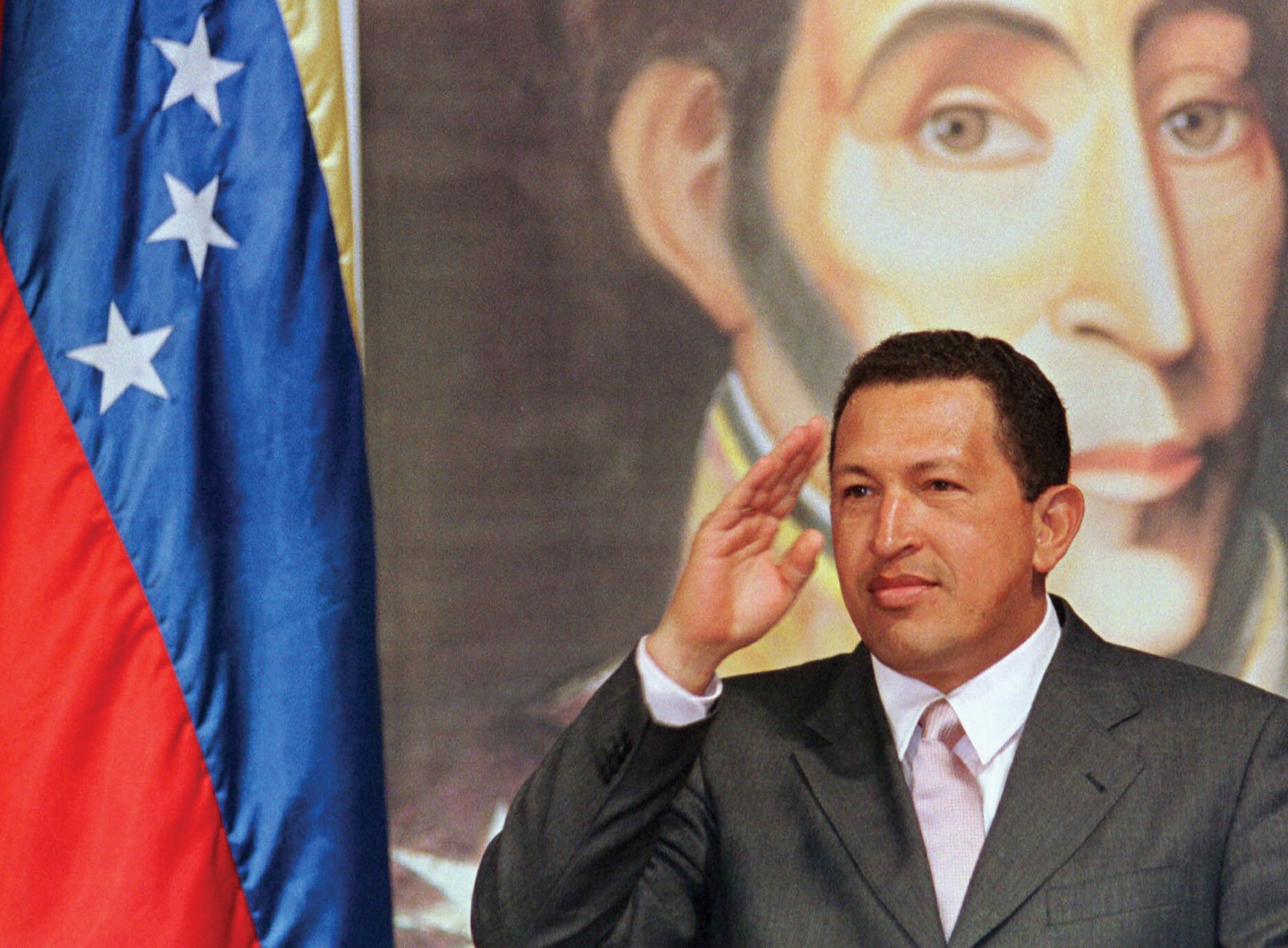
Commander Hugo Chávez Frías
July 28, 1954-March 5,
2013
March 5 marks
the fifth anniversary of the passing of
Comandante Hugo Chávez Frías, historic leader of the
Bolivarian
Revolution and President of the Bolivarian Republic of Venezuela
from 1999 until his untimely death on March 5, 2013.
The name and legacy of Hugo Chávez are indelibly
marked by
his work for the well-being of the Venezuelan people and defence
of their national sovereignty, the struggle for the independence
of Venezuela and all of Latin America and the Caribbean from
imperialist tutelage and plunder, and for peace on the world
scale as well as in his own region.
In his 14 years as President and before, Hugo
Chávez took up
the defence of the people's interests at home and abroad. His
life and work were an outstanding contribution to the aspirations
of the peoples of Latin America and the Caribbean and all those
around the world fighting to build the new. Under his leadership
Venezuela began its world renowned Bolivarian Missions to address
the basic needs of the population through programs that provide
free access to services in areas such as health, nutrition,
education, housing and job training as well as fostering their
ability to participate in cultural and political affairs.
|

Portrait of Chavez carried in mass action in support of the Bolivarian
republic,
April 19, 2017.
|
Hugo Chávez played a leading role in the launch
of important
regional integration initiatives aimed at assisting the countries
of Latin America and the Caribbean to engage in mutually beneficial
relations while curtailing the ability of the U.S. to pit them
against one another to facilitate its dominance over the region.
These included the Bolivarian Alliance for the Peoples of Our
America (ALBA) - People's Trade Agreement, intiated with Cuba in
2004; Petrocaribe, a development project through which a host of
Caribbean and Central American countries are able to purchase oil
from Venezuela on preferential payment terms while investing in
programs aimed at bettering the lives of their people; the Union
of South American Nations (UNASUR) and the Community of Latin
American and Caribbean States (CELAC) as expressions of the
peoples' desire for regional solidarity and national sovereignty
free from outside interference by U.S. imperialism and its junior
partner Canada, who use their membership in the Organization of
American States (OAS) for this purpose.
The stands of President Chávez and the
Government of the
Bolivarian Republic of Venezuela in defence of sovereignty and
independence and against imperialist war were also great
contributions to the movement for peace and against war
internationally.
At a time when NATO states and others under U.S.
domination,
including Canada, were using the platform of the United Nations
to violate its Charter and founding principles by passing
resolutions condoning the bombing and invasion of sovereign
countries and calling for the removal of their governments by
force, all in the name of high ideals like "human rights",
"democracy" and "the responsibility to protect civilians", Hugo
Chávez and the Bolivarian Government of Venezuela never joined
this treachery. They could be counted on to denounce it for what
it was. For this, President Chávez was respected by peace-loving
people the world over.
These are all achievements which only a historic
personality
could possibly accomplish.
Chávez knew the Venezuelan people would face a
difficult battle after he was gone and called on them to remain
vigilant and to "fight, fight, fight imperialism." Today this is what
they are doing with might and mane as the forces of the old, desperate
to reverse the course of history, are going all out under the baton of
U.S. imperialism to destroy their nation-building project.
On the occasion of the fifth anniversary of the tragic
loss
of Comandante Hugo Chávez, CPC(M-L) reiterates its pledge to
honour his memory by making every effort to ensure the
achievements of the Bolivarian Revolution are defended in Canada,
and that the dirty work Canada is carrying out as part of the
U.S. imperialist project for regime change in Venezuela to
disempower the people and rob them of their achievements meets
with active opposition in Canada and Quebec.
Long Live the Legacy of Hugo
Chávez!
Support the
Right of the
Venezuelan People to Defend Their Nation-Building Project!
U.S.
and Canada, Hands off Venezuela!

Bolivarian Alliance for the Peoples of Our America (ALBA) -
People's Trade Agreement summit
in Caracas, Venezuela, March 5,
2017, honours Hugo Chávez on fourth anniversary of his death.

PREVIOUS
ISSUES | HOME
Website: www.cpcml.ca
Email: editor@cpcml.ca
|





 The Anishinaabek people have
been fighting for
appropriate
increases in their annuity payments since the beginning. In 1877,
only three years after the last increase, the seventeen Chiefs of
the Lake Huron bands petitioned the Canadian government for an
increase in the annuity payment. Such petitions were a regular
occurrence during the last decades of the nineteenth century. In
1887, the Parry Island band petitioned the government providing
an oral tradition of what had been said to their Chiefs at
Penetanguishene in 1850. However, neglecting its
responsibilities, the Ontario government has undertaken no
accounting of the value of the resources extracted from
Anishinaabek lands despite their treaty obligations since the
1890s.
The Anishinaabek people have
been fighting for
appropriate
increases in their annuity payments since the beginning. In 1877,
only three years after the last increase, the seventeen Chiefs of
the Lake Huron bands petitioned the Canadian government for an
increase in the annuity payment. Such petitions were a regular
occurrence during the last decades of the nineteenth century. In
1887, the Parry Island band petitioned the government providing
an oral tradition of what had been said to their Chiefs at
Penetanguishene in 1850. However, neglecting its
responsibilities, the Ontario government has undertaken no
accounting of the value of the resources extracted from
Anishinaabek lands despite their treaty obligations since the
1890s.

 Stoneman Douglas students
were supported by some 1,000 of
their peers from West Boca High School. Those students walked out
of class and travelled 12 miles en masse to Stoneman
Douglas. Students at the school have also organized to ensure
their story is told, raising funds for printing their newspaper
with support from across the country.
Stoneman Douglas students
were supported by some 1,000 of
their peers from West Boca High School. Those students walked out
of class and travelled 12 miles en masse to Stoneman
Douglas. Students at the school have also organized to ensure
their story is told, raising funds for printing their newspaper
with support from across the country.


 The Communist Party of Canada
(Marxist-Leninist) salutes
the women of Canada, Quebec and the Indigenous peoples and women
the world over on the occasion of International Women's Day 2018.
The fight waged by women and girls to affirm their rights is
courageous, heroic, inspiring and decisive in the fight for the
rights of all. At a time counter-revolution has the initiative
worldwide, with its vicious neo-liberal agenda, anti-social offensive,
privatizations, aggressions and wars, women stand in the front ranks of
the struggle to affirm their rights in all fields of human endeavour.
This is the struggle that opens society's path to progress, especially
since all these attacks are carried out, amongst other things, in the
name of women and their rights! To the chagrin of the elites, women are
not fighting for their rights to satisfy the
agenda of elites but to make sure conditions are brought into
being where even the notion of women as a legitimate target of attack
is a thing of
the past. On this occasion, CPC(M-L) calls on all members of the
polity to stand as one to affirm a society which does not
discriminate against women and girls and consider them fair
game.
The Communist Party of Canada
(Marxist-Leninist) salutes
the women of Canada, Quebec and the Indigenous peoples and women
the world over on the occasion of International Women's Day 2018.
The fight waged by women and girls to affirm their rights is
courageous, heroic, inspiring and decisive in the fight for the
rights of all. At a time counter-revolution has the initiative
worldwide, with its vicious neo-liberal agenda, anti-social offensive,
privatizations, aggressions and wars, women stand in the front ranks of
the struggle to affirm their rights in all fields of human endeavour.
This is the struggle that opens society's path to progress, especially
since all these attacks are carried out, amongst other things, in the
name of women and their rights! To the chagrin of the elites, women are
not fighting for their rights to satisfy the
agenda of elites but to make sure conditions are brought into
being where even the notion of women as a legitimate target of attack
is a thing of
the past. On this occasion, CPC(M-L) calls on all members of the
polity to stand as one to affirm a society which does not
discriminate against women and girls and consider them fair
game.
 One hundred and seven years ago,
the first
International
Women's Day was celebrated to focus on the call for peace issued
by communist women in Europe prior to the First World War. Since
then, life experience has confirmed that women are the mightiest
force for peace on the world scale. This is represented today by
the work to Make Canada a Zone for Peace and to establish an
anti-war government which gets Canada out of war alliances,
coalitions and cartels of all kinds, including economic,
military, cultural or any other. Today, Canada is embroiled in all
U.S. wars of aggression, occupation and regime change. It is a member
of alliances and coalitions which are threatening all peoples who
refuse to submit to U.S. dictate. On the occasion of
International Women's Day 2018, let us step
up the fight to establish an anti-war government and make Canada
a Zone for Peace.
One hundred and seven years ago,
the first
International
Women's Day was celebrated to focus on the call for peace issued
by communist women in Europe prior to the First World War. Since
then, life experience has confirmed that women are the mightiest
force for peace on the world scale. This is represented today by
the work to Make Canada a Zone for Peace and to establish an
anti-war government which gets Canada out of war alliances,
coalitions and cartels of all kinds, including economic,
military, cultural or any other. Today, Canada is embroiled in all
U.S. wars of aggression, occupation and regime change. It is a member
of alliances and coalitions which are threatening all peoples who
refuse to submit to U.S. dictate. On the occasion of
International Women's Day 2018, let us step
up the fight to establish an anti-war government and make Canada
a Zone for Peace.

 Canadian and Indigenous women's
organizations and child care
advocates agree that the government must recognize rights by
providing affordable child care, upholding the rights of early
childhood educators to wages and benefits commensurate with the
value they create, and expanding public and not-for-profit private day
care, with no expansion of private for-profit care. They
further call for a National Child Care Program to uphold the
rights of children, women and workers in early childhood
education and child care. They point out that services are scarce,
child care space availability is uneven, fees are unaffordable,
quality is uneven, and workers are grossly underpaid for the
important work they do and value they add to the economy.
Canadian and Indigenous women's
organizations and child care
advocates agree that the government must recognize rights by
providing affordable child care, upholding the rights of early
childhood educators to wages and benefits commensurate with the
value they create, and expanding public and not-for-profit private day
care, with no expansion of private for-profit care. They
further call for a National Child Care Program to uphold the
rights of children, women and workers in early childhood
education and child care. They point out that services are scarce,
child care space availability is uneven, fees are unaffordable,
quality is uneven, and workers are grossly underpaid for the
important work they do and value they add to the economy.  Regarding "compromise proposals,"
Canadian
Press
reports that in response to U.S. demands to increase U.S. content in
produced autos, "Canada (our side) suggested new ways to
calculate whether a car counts as American. The new formulas
would inflate U.S. numbers somewhat by including areas where the
U.S. dominates, such as intellectual property and research. It
did not address U.S. demands for specific numeric targets for
parts production." Well isn't that sweet! We can fudge the
numbers and Trump will be happy. How does this move us forward
towards self-reliant steel, vehicle and machinery building
sectors that do not depend on what the financial oligarchs do or do not
want or consider good enough to make America great again?
Regarding "compromise proposals,"
Canadian
Press
reports that in response to U.S. demands to increase U.S. content in
produced autos, "Canada (our side) suggested new ways to
calculate whether a car counts as American. The new formulas
would inflate U.S. numbers somewhat by including areas where the
U.S. dominates, such as intellectual property and research. It
did not address U.S. demands for specific numeric targets for
parts production." Well isn't that sweet! We can fudge the
numbers and Trump will be happy. How does this move us forward
towards self-reliant steel, vehicle and machinery building
sectors that do not depend on what the financial oligarchs do or do not
want or consider good enough to make America great again? The controversy reveals that
the fight over the NAFTA
negotiations and what will be inside, outside or tweaked, and
whether it becomes bilateral or trilateral is being fought out by
contending private monopoly interests without any consideration
for the well-being and rights of the people. Who has authority
for the making of regulations and setting standards and with what
aim are fundamental matters of principle. Successive Canadian
governments have permitted Canadian regulatory powers to be
delegated and sub-delegated to private interests and foreign
powers to such an extent that regulations made in other countries
can de facto become the standard in Canada beyond any
control of Canadians.
The controversy reveals that
the fight over the NAFTA
negotiations and what will be inside, outside or tweaked, and
whether it becomes bilateral or trilateral is being fought out by
contending private monopoly interests without any consideration
for the well-being and rights of the people. Who has authority
for the making of regulations and setting standards and with what
aim are fundamental matters of principle. Successive Canadian
governments have permitted Canadian regulatory powers to be
delegated and sub-delegated to private interests and foreign
powers to such an extent that regulations made in other countries
can de facto become the standard in Canada beyond any
control of Canadians.
 On February 5, Canada's
Minister of Public Safety Ralph
Goodale met with U.S. Homeland Security Secretary Kirstjen
Nielsen. Preclearance was a main item on the agenda. The Canadian
Press wrote: "Imagine clearing Canadian customs
in Florida, Arizona, or Chicago, or having a U.S. customs
facility attached to a car plant in Ontario, with the goal of
helping people and cargo travel faster between the countries. The
Canadian and American governments are discussing it."
On February 5, Canada's
Minister of Public Safety Ralph
Goodale met with U.S. Homeland Security Secretary Kirstjen
Nielsen. Preclearance was a main item on the agenda. The Canadian
Press wrote: "Imagine clearing Canadian customs
in Florida, Arizona, or Chicago, or having a U.S. customs
facility attached to a car plant in Ontario, with the goal of
helping people and cargo travel faster between the countries. The
Canadian and American governments are discussing it."



























 The exhibit follows traditional
Indigenous ceremonial protocols. The work exists primarily as a floor
installation made up of the beaded vamps arranged in a winding path
formation on fabric. Viewers remove their shoes to walk on a path of
cloth alongside the unsewn vamps. The unfinished moccasins represent
the unfinished lives of the women and girls who have been murdered or
who are still missing. The women have been cared for; they have been
loved; they are missing; they are missed; they are not forgotten. More
than 3,000 people visited the exhibition over the ten days that the
commemoration was open to the public.
The exhibit follows traditional
Indigenous ceremonial protocols. The work exists primarily as a floor
installation made up of the beaded vamps arranged in a winding path
formation on fabric. Viewers remove their shoes to walk on a path of
cloth alongside the unsewn vamps. The unfinished moccasins represent
the unfinished lives of the women and girls who have been murdered or
who are still missing. The women have been cared for; they have been
loved; they are missing; they are missed; they are not forgotten. More
than 3,000 people visited the exhibition over the ten days that the
commemoration was open to the public.


